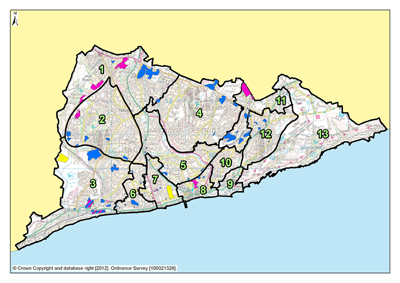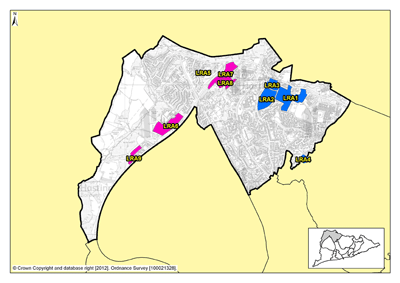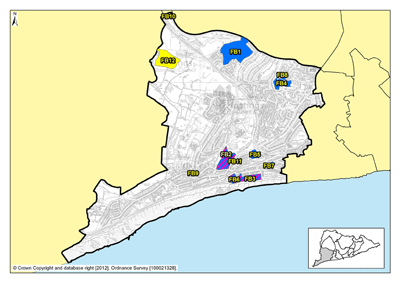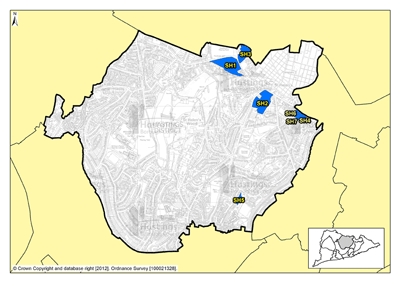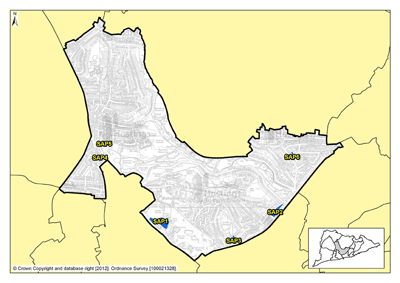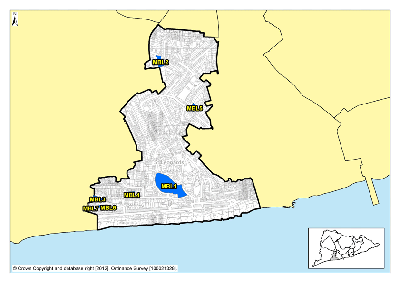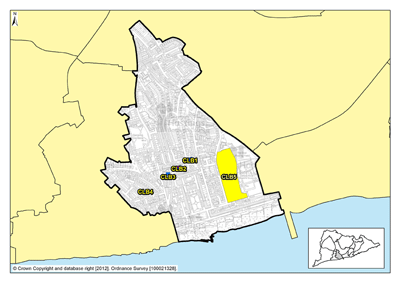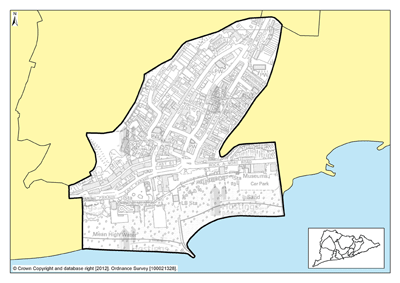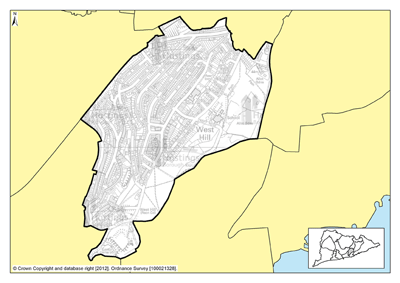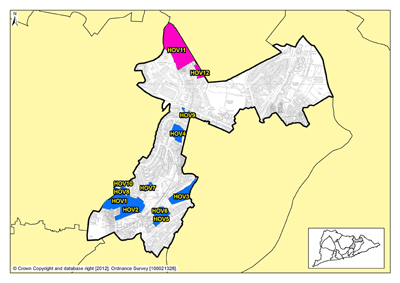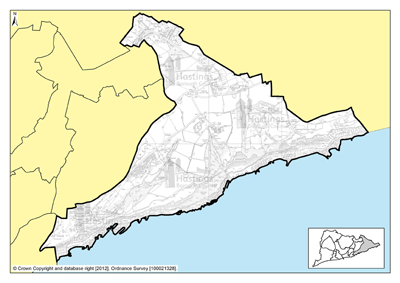Hastings Development Management Plan Proposed Submission Version
(4) Section Six – Site Allocations
(8) 6.1 Policy DS1 of the Planning Strategy sets a target of 3400 new homes to meet the housing needs of Hastings between 2011 and 2028. This will not all be new housing allocations, as the total includes homes completed and under construction and existing planning permissions. Strategic policies FA1, FA2 and FA5 show a broad distribution of the proposed housing land supply. Individual sites are to be identified in this Plan.
| Hastings Planning Strategy - Chapter 4: The Development Strategy | |
| DS1 | New Housing Development |
| DS2 | Employment Growth |
| DS3 | Location of Retail Development |
Table 7: Hastings Planning Strategy - Chapter 4
| Hastings Planning Strategy - Chapter 5: Spatial Areas | |
| FA1 | Strategic Policy for Western Area |
| FA2 | Strategic Policy for Central Area |
| FA3 | Strategy for Hastings Town Centre |
| FA4 | Strategy for Central St Leonards |
| FA5 | Strategic Policy for Eastern Area |
| FA6 | Strategic Policy for the Sea Front |
Table 8: Hastings Planning Strategy - Chapter 5
6.2 Similarly, policy DS2 identifies a need for the development of up to 70,000 sq metres of employment floor space in the town between 2008 and 2028. This is to be achieved through a combination of existing and new sites.
6.3 To provide a local perspective and sense of place, the Planning Strategy divides the town into 13 Focus Areas. These are areas based upon statistical Super Output Areas and they have an identifiable community or geography or where landscape or function means that they make a logical area for spatial planning. A plan showing the boundaries of the 13 areas is shown over the page.
6.4 This section of the Development Management Plan looks at the Focus Areas in some detail. Set out within the pages for each area is a description of the main characteristics of it and a vision for its future. The housing and employment allocations (including existing permitted sites) and some other identified sites for each Focus Area are set out in a schedule. This is followed by a small site map and accompanying allocation details. Some larger sites also have a design brief set out in Appendix A.
(1) 6.5 The allocations of this plan show those sites that the Council broadly supports for development. The details accompanying the allocations (on the following pages), identify known constraints and potential solutions. The accompanying detail to each site outlines which policies of both the Planning Strategy and Development Management Plan are of particular importance to consider, but this is not an exhaustive list. For references please refer to Appendix C – The indices of policies. All sites, however, will (or have been) subject to the requirements of a planning application, where site specific issues and detailed development proposals will be investigated.
6.6 Two of the sites that have been identified have an accompanying policy and these are:
| Policy FBX - Former West St Leonards Primary School | 106 |
| Policy CLBX - Former Convent of Holy Child Jesus, Magdalen Road | 159 |

The Planning Focus Areas
(3) Focus Area 1: Little Ridge & Ashdown
6.7 This is where Hastings’ urban fringe meets the surrounding countryside, with recent housing developments edging into woodland, fields and farmland. It is where visitors to Hastings arriving by road from London get their first glimpse of the sea, with long and often breathtaking views, especially from high points on The Ridge.
6.8 Little Ridge & Ashdown covers the parts of the Borough to the north of Silverhill and west from the Conquest Hospital, including semi-rural areas to the west of Queensway. It is a mixed area, with good quality and well maintained, predominately post-war, housing and two of the town’s largest employers: the Conquest Hospital and the Child Support Agency. The area includes a major supermarket whose draw extends well beyond the immediate locality and some other retail outlets. The presence of various employers in the Focus Area, including tourist accommodation at the Beauport Park holiday village, the Premier Inn and Bannatyne’s hotel and spa, and leisure developments, create opportunities for people to live and work in relatively close proximity, allows local workers the chance to walk or cycle to work. A mix of housing will help to maintain a vibrant community.
6.9 There are also good public transport connections to the Conquest Hospital, supermarkets, to Hastings town centre and beyond. The connectivity allows for a choice of travel options for work and pleasure. This connectivity does, however, come at the cost of some particularly busy roads, and the junctions of the A259, the A21 and The Ridge lie within this area.
6.10 However, Little Ridge & Ashdown is not just a mix of housing and industrial suburbia. There are recreation grounds, allotments, extensive areas of open farmland at the western fringe of the Borough and, most significantly, the Marline Valley, a Site of Special Scientific Interest (SSSI) which includes woodland, meadows and a steep-sided valley covering forty hectares of open space to the west of Queensway.
6.11 Housing in Ashdown & Little Ridge is predominately owner-occupied (according to 2001 Census data over 80% of the residences are owned by their occupants), and most are suburban family homes. The demographic data for the area (again from the 2001 Census), shows an even mix of age groups, reinforcing the fact that this is an area where many families live.
Our Vision for Little Ridge & Ashdown
6.12 A major change to this area during the Plan period is likely to be the construction of the Bexhill - Hastings Link Road. This will allow drivers the choice to travel either on Bexhill Road and Hastings seafront, or onto The Ridge to continue their journeys east and west. It will also allow for better and simpler access to the A21 for travel north towards London. The Baldslow Link will also be an important part of improved road connections. Whilst the Bexhill - Hastings Link Road will improve transport options for local people, businesses and tourists; careful management of traffic flow, especially at existing major junctions and near potential development sites, will need to be considered. Development proposals all along The Ridge will need to show consideration of the traffic impact onto and off of this locally important traffic route.
6.13 Building the Link Road could also aid in the development of commercial and employment areas along Queensway, particularly at the northern end. Better traffic flow in these areas will help to increase the opportunities for improved access to the sites. This is an opportunity for new commercial developments offering extra employment opportunities, but it should not be to the detriment of ecology, particularly the woodland, of the area.
6.14 Public open spaces are important here in blending the urban area into the surrounding countryside. The Marline Valley SSSI will continue to be protected. Allotments and open spaces are important to local communities and these will be managed and where possible enhanced. Tourist accommodation provision in Little Ridge & Ashdown is something that the Council would also like to see protected and we will consider ways to increase it.
6.15 Policy FA1 of the Hastings Planning Strategy states that the provision for 220 – 280 extra homes is required in Little Ridge and Ashdown over the next fifteen years, and most of these will be delivered through new development on allocated sites. There is a particular development opportunity at Holmhurst St Mary, a former convent school and surrounding grounds, land next to it at 777 the Ridge and the neighbouring playing field. Together, these sites have the potential to provide a significant number of new homes, with a mix of properties for all, including families, workers for the hospital, and employees of the local light industrial and commercial sites. A benefit of these sites coming forward together in a well phased manner could be to allow for an integrated development, including an improvement to the recreation facilities and the opportunity for the community to take some ownership, and for locally important wildlife habitats and green spaces to be protected and also properly connected.
6.16 South of The Ridge West and along Queensway, there are opportunities to increase the volume of industrial and commercial premises and to strengthen the links between the Hastings labour force and the town’s exports and the wider market of the UK and beyond. The proposed Bexhill - Hastings Link Road will aid in the continued growth of business and employment in this part of the Borough. Situating these kinds of premises near to one another increases the opportunities for similar businesses to set up and share expertise and knowledge. The new commercial area on Queensway – the Queensway Employment Corridor – with the Enviro 21 Park, an environmentally sustainable industrial park, will act as a catalyst to other businesses and premises. These, and the presence of the Sussex Exchange Business Centre, means that future employment opportunities in this area are strong.
6.17 The eclectic nature of architectural styles in Little Ridge & Ashdown allows for development proposals of all sizes to have a degree of flexibility. There is a need to provide a mixture of tenures in the area where possible, in order to maintain a sustainable community which has access to a range of local shops and services. We will continue to encourage the inclusion of affordable and social housing in schemes, especially in this Focus Area, where there is less provision than elsewhere. Affordable housing, especially for locally employed people, a small amount of flatted development and also some larger family homes will maintain the suburban feel of this area of the Borough, and help to maintain the quality of the built environment.
Allocations for Little Ridge and Ashdown
| Site reference | Address | Reason for allocation (including potential number of homes) | Area (ha) | Does the site have a brief in Appendix A? |
|---|---|---|---|---|
| LRA1 | Holmhurst St Mary | Residential (165) | 6.98 |

|
| LRA2 | Harrow Lane Playing Fields | Residential (140) | 4.75 |

|
| LRA3 | Land adjacent to 777 The Ridge | Residential (10) | 1.86 |

|
| LRA4 | Old Roar House, Old Roar Road | Residential (14) | 0.84 |

|
| LRA5 | Former Workplace Health & Fitness Centre, The Ridge West | Residential (11) | 0.47 |

|
Table 9: Allocations for Little Ridge & Ashdown
Employment Allocations
| Site reference | Address | Potential gross floorspace (m2) | Area (ha) | Does the site have a brief in Appendix A? |
|---|---|---|---|---|
| LRA6 | Queensway North, Queensway | 9,700 | 4.70 |

|
| LRA7 | Land at junction of The Ridge West and Queensway |
6,000 Up to 12,000 if combined with site LRA8 |
3.37 |

|
| LRA8 | Land in Whitworth Road, The Ridge West |
6,000 Up to 12,000 if combined with site LRA7 |
2.51 |

|
| LRA9 | Marline Fields, Enviro21 Business Park, Land West of Queensway | 5,600 | 1.48 |

|
Table 10: Employment allocations for LRA
 Site reference: LRA1 - Holmhurst St Mary
Site reference: LRA1 - Holmhurst St Mary

Figure 7: LRA1 - Holmhurst St Mary
Site address: Holmhurst St Mary
Allocated use: Residential
Area: 6.98ha
Possible net capacity: 165
(1) 6.18 Site LRA1 – Holmhurst St Mary – was previously a ‘reserve site’ in the Local Plan 2004. This, however, will no longer be the case; the Council now allocates the site for residential development with an indicative capacity of 165 units. The form of any proposed development would need to take into account such matters as the established landscaping, the ecology and the position of a Grade II* listed statue (the statue is currently on the English Heritage “at risk” register and will need to be repaired and consolidated as part of any development scheme). Proposals for this site will need to include a traffic impact assessment, especially because of its close proximity to The Ridge. Particular reference should be made to Policies DM1, DM3, DM4, HN1, HN4 and HN8 of this plan. In accordance with Policy H2 of the Planning Strategy; this site may be required to include specific housing for wheelchair users and with Policy H3, Affordable Housing will be required to be provided. Of particular importance for this site will be measures to reduce surface water flood risk, in accordance with Policy SC7, of the Planning Strategy, Sustainable Drainage Systems (SUDs) are likely to be required.
6.19 The two neighbouring sites LRA2 and LRA3 give the opportunity for effective connected planning. This would allow for greater walking and cycling connectivity and also an enhancement of the Green Infrastructure Network in this area, between open and green spaces to support their ecological and recreational value. The combination of these three sites and the proximity of the hospital also provide the potential for district heating, so with reference to policy SC5 of the Planning Strategy, the Council expects the proponents of any scheme on each of the LRA1, LRA2 and LRA3 sites to investigate the feasibility of district heating networks and/or combined heat and power systems.
6.20 A suggested design brief – in Appendix A – is to be used as a guide and not to determine applications. It gives some ideas about how the connectivity and the landscaping might be achieved. The brief also shows some other details that are considered to be acceptable solutions for the site.
(1)
 Site reference: LRA2 - Harrow Lane Playing Fields
Site reference: LRA2 - Harrow Lane Playing Fields

Figure 8: LRA2 - Harrow Lane Playing Fields
Site address: Harrow Lane Playing Fields
Allocated use: Residential
Area: 4.75 ha
Possible net capacity: 140
(1) 6.21 Site LRA2 – Harrow Lane playing fields – was protected in the Local Plan 2004 as playing fields. Its use as a site for football fields/active recreation has ceased, and it is now surplus to open space provision requirement. Therefore the Council allocates this site for residential use.
6.22 LRA2 is an elevated site situated above the road and the office and residential area to the east. The boundary of the site is made up of well treed hedgerows, except at the south west corner where there are long views to Beachy Head. This site is allocated for residential development that incorporate measures to help maintain its current overall appearance of a wooded site with strengthened boundary planting. There are also public rights of way running around the perimeter which would have to be accommodated within any development proposals. Proposals for this site will need to include a traffic impact assessment, especially because of its close proximity to The Ridge. Any proposal will have to include solutions to these issues with reference to policies DM1, DM3, DM4 and HN9 of this plan, and local knowledge also suggests that surface water flood risk may be an issue, so policy SC7 of the Planning Strategy is likely to be important. In accordance with Policy H2 of the Planning Strategy, this site may be required to include specific housing for wheelchair users and Affordable Housing will be required to be provided in accordance with Policy H3.
6.23 The two neighbouring sites LRA1 and LRA3 give the opportunity for effective connected planning. This would allow for greater walking and cycling connectivity and also an enhancement of the Green Infrastructure Network in this area, between open and green spaces to support their ecological and recreational value. Of particular importance will be the connectivity to the open space beyond LRA1, as the loss of the existing amenity of the playing fields will be lessened by access to other open space. The combination of these three sites and the proximity of the hospital also provide the potential for district heating, so with reference to policy SC5 of the Planning Strategy, the Council expects the proponents of any scheme on each of LRA1, LRA2 and LRA3 sites, to investigate the feasibility of district heating networks and/or combined heat and power systems.
6.24 A suggested design brief – in Appendix A – is to be used as a guide and not to determine applications. It gives some ideas about how the connectivity and the landscaping might be achieved. The brief also shows some other details that are considered to be acceptable solutions for the site.
 Site reference: LRA3 - Land adjacent to 777 The Ridge
Site reference: LRA3 - Land adjacent to 777 The Ridge

Figure 9: LRA3 - Land adjacent to 777 The Ridge
Site address: Land adjacent to 777 The Ridge
Allocated use: Residential
Area: 1.86ha
Possible net capacity: 10
(1) 6.25 Site LRA3 – Land adjacent to 777 The Ridge – is a greenfield site occupying an elevated position at the junction of Harrow Lane with The Ridge. The site does not fall within any landscape designation but the Area of Outstanding Natural Beauty (AONB) lies on the opposite side of The Ridge. There are long views to the north into and out of the AONB, and this is likely to constrain the scale and form of development on this site. Planting on the northern boundary could enable part of the site to be developed but low profile development would be essential on this elevated site. Proposals will need to include a traffic impact assessment, especially because of its close proximity to The Ridge. Any proposal will have to include solutions to these issues with reference to policies DM1, DM3, DM4 and HN9 of this plan, and local knowledge also suggests that surface water flood risk may be an issue, so policy SC7 of the Planning Strategy is likely to be important. Affordable Housing will be required to be provided in accordance with Policy H3 of the Planning Strategy.
6.26 The two neighbouring sites LRA1 and LRA2 give the opportunity for effective connected planning. This would allow for greater walking and cycling connectivity and also an enhancement of the Green Infrastructure Network in this area, between open and green spaces to support their ecological and recreational value. The combination of these three sites and the proximity of the hospital also provide the potential for district heating, so with reference to policy SC5 of the Planning Strategy, the Council expects the proponents of any scheme on each of LRA1, LRA2 and LRA3, to investigate the feasibility of district heating networks and/or combined heat and power systems.
6.27 A suggested design brief – in Appendix A – is to be used as a guide and not to determine applications. It gives some ideas about how the connectivity and the landscaping might be achieved. The brief also shows some other details that are considered to be acceptable solutions for the site.
 Site reference: LRA4 - Old Roar House, Old Roar Road
Site reference: LRA4 - Old Roar House, Old Roar Road

Figure 10: LRA4 - Old Roar House, Old Roar Road
Site address: Old Roar House, Old Roar Road
Allocated use: Residential
Area: 0.84ha
Possible net capacity: 14
6.28 Site LRA4 – Old Roar House, Old Roar Road – has a lapsed planning permission for residential development, the site’s suitability for residential development has been established.
6.29 The details of the lapsed permission, number HS/OA/07/00997, can be found at: www.ukplanning.com
6.30 The decision made on application HS/OA/07/00997 will inform any discussions about future proposals on site LRA4. It should be noted that this site is adjacent to a Local Wildlife Site (Alexandra Park) so any new scheme should demonstrate how it complies with Policy EN3 of the Planning Strategy and HN9 of this Plan.
 Site reference: LRA5 - Former Workplace health & fitness
centre, The Ridge West
Site reference: LRA5 - Former Workplace health & fitness
centre, The Ridge West

Figure 11: LRA5 - Former Workplace health & fitness Centre, The Ridge West
Site address: Former Workplace health & fitness centre, The Ridge West
Allocated use: Residential
Area: 0.47ha
Possible net capacity: 11
6.31 Site LRA5 – Former Workplace health & fitness centre, The Ridge West – where the suitability of developing it for housing has been established through an approved planning application; is allocated for residential development.
6.32 The details of the scheme, number HS/FA/10/00005, can be found at: www.ukplanning.com
6.33 In the event of a permission lapsing the decision made on application HS/FA/10/00005 will inform any discussions about future proposals on site LRA5.
6.34 Any scheme on this site will need to pay particular attention to its potential impact on a Grade II listed building opposite it - Croft Lodge House.
 Site reference: LRA6 - Queensway North, Queensway
Site reference: LRA6 - Queensway North, Queensway

Figure 12: LRA6 - Queensway North, Queensway
Site address: Queensway North, Queensway
Allocated use: Employment; use class B1
Area: 4.70ha
Potential floorspace (gross): 9,700m2
6.35 Site LRA6 – Queensway North, Queensway – has been allocated for employment for a considerable period. Its “partner” site, Queensway South, has been partially developed as part of the Enviro21 Business Park scheme and this could form a next phase. It is seen as suitable for high quality business development, possibly for a single large user or more likely for several medium sizes business units or a range of small ones. It has the potential for a total of c. 9,700m2 of floorspace.
6.36 The site adjoins a Site of Special Scientific Interest and any development would need to ensure that there is minimal ecological impact on the protected site, in particular the hydrological effects on drainage into the Marline Valley stream. The site itself is undulating and covered mainly in scrub and some woodland, which should be fully surveyed ecologically to assess what constraints to development these represent.
6.37 There are chalets and residential properties to the west and north of the site and the effect on these should be taken into account in the design, with buffer landscaping where appropriate.
6.38 It is anticipated that the site will be served by a single looped spine road accessed directly off Queensway - with a simple main “T” junction and a secondary “emergency only” junction. Limited improvements to Queensway itself may be required. A pedestrian connection to the adjoining chalet site or the residential area should be considered, in consultation with residents.
6.39 Potential applicants should pay particular attention to policies DM1, DM2, and DM4 of this Plan. Policies DM5, DM6 and DM7 may also be of relevance. Within the Planning Strategy, transport policies T3 and T4, and environment policy EN3 are particularly applicable. Of particular importance for this site will be measures to reduce surface water flood risk, in accordance with Policy SC7, and Sustainable Drainage Systems (SUDs) are likely to be required.
 Site reference: LRA7 - Land at the junction of The Ridge West
and Queensway
Site reference: LRA7 - Land at the junction of The Ridge West
and Queensway

Figure 13: LRA7 - Land at the junction of The Ridge West and Queesway
Site address: Land at the junction of The Ridge West and Queensway
Allocated use: Employment; use class B1
Area: 3.37ha
Potential floorspace (gross): 6,000m2. If combined with site LRA8: up to 12,000m2
6.40 Site LRA7 – Land at junction of The Ridge West and Queensway – is a greenfield site in the ownership of East Sussex County Council. Planning permission exists on the northern portion of this site for a residential care home scheme5. However, if the County Council's plans in this respect were not to take place, and site were to be available for development during the Plan period, the Borough Council’s preference would be to see it developed for employment purposes. The site is therefore allocated for this purpose.
6.41 Taken together with an adjoining employment allocation, Site LRA8, this location would offer the potential to create a high quality employment estate with a prominent frontage onto The Ridge - a key corridor in the local road network once the Bexhill Hastings Link Road is open - which would considerably assist its commercial potential. The two sites combined have an area of 5.88ha and a potential capacity of up to 12,000m2.
6.42 The site itself is gently sloping although there is a more marked level difference where it joins site LRA8. It is mainly open grassland but it contains some woodland and is surrounded by belts of trees. An ecological and landscape survey would be required to assess the extent to which these factors would constrain development.
6.43 For a development of this scale, a new access off an improved roundabout at the junction of The Ridge West and Queensway is expected to be required. From the junction, a spine road should be designed to extend through to serve both sites – LRA7 and LRA8. The land is considered able to accommodate class B1 business units of a range of sizes.
6.44 Potential applicants should pay particular attention to policies DM1, DM3, and DM4 of this Plan. Policies DM5, DM6 and DM7 may also be of relevance. Within the Planning Strategy, transport policies T2, T3 and T4, and environment policies EN2 and EN3 are particularly applicable.
 Site reference: LRA8 - Land in Whitworth Road, The Ridge West
Site reference: LRA8 - Land in Whitworth Road, The Ridge West

Figure 14: LRA8 - Land in Whitworth Road, The Ridge West
Site address: Land in Whitworth Road, The Ridge West
Allocated use: Employment; use class B1
Area: 2.51ha
Potential floorspace (gross): 6,000m2 If combined with site LRA7: up to 12,000m2
6.45 Site LRA8 – Land in Whitworth Road, The Ridge West – has been allocated for employment development for many years but until recently was affected by possible routes for the Baldslow Junction highway improvement scheme. That scheme was cancelled under the Government’s National Spending Review in 2010. However, with the related Bexhill - Hastings Link Road now approved and with construction starting in 2013, the Highway Authority, East Sussex County Council, is expected to review the traffic implications for the Baldslow area again and bring forward alternative proposals. Nevertheless, the position at 2012 is that this site is not formally affected by any highway proposal and is therefore considered to be available for development.
6.46 The site is capable of being brought forward as a natural extension of the West Ridge employment area. Developed in this form, access may be possible by means of an extension of Whitworth Road (subject to some widening) or, alternatively, John MacAdam Way to the south was constructed in a form which would allow it to be extended into the site to provide access.
6.47 The site falls within a Local Wildlife Site and is therefore subject to Policy EN4. It is located at the head of a shallow valley formed by the Hollington Stream which is part of the Green Infrastructure Network (See Policy EN2). It is partially wooded. A full ecological survey and a landscape assessment will be required to assess the extent to which these factors would constrain any development. The floorspace achievable on this site could be significantly affected by the findings of this work.
6.48 This site adjoins land to the north – Site LRA7 – which, if combined, would have capacity to enable the creation of a high quality employment estate with direct frontage onto The Ridge, and which would considerably enhance its commercial potential.
6.49 Potential applicants should pay particular attention to policies DM1, DM2, and DM4 of this Plan. Policies DM5, DM6 and DM7 may also be of relevance. Within the Planning Strategy, transport policies T3 and T4, and environment policies EN2 and EN3 are particularly applicable. A small part of this site is affected by Flood Zone 3, so a flood risk assessment will be required with any proposals and measures to reduce surface water flood risk – Sustainable Drainage Systems (SUDs) for example – are likely to be required, in accordance with Policy SC7 of the Planning Strategy.
 Site reference: LRA9 - Marline Fields, Enviro21 Business
Park, Land West of Queensway
Site reference: LRA9 - Marline Fields, Enviro21 Business
Park, Land West of Queensway

Figure 15: LRA9 - Marline Fields, Enviro21 Business Park, Land West of Queensway
Site address: Marline Fields, Enviro21 Business Park, Land West of Queensway
Allocated use: Employment; use class B1
Area: 1.48ha
Potential floorspace (gross): 5,600m2
6.50 Site LRA9 – Marline Fields, Enviro21 Business Park, Land West of Queensway – is part of a larger site. Four high quality business units and the access spine road have already been constructed under the Enviro21 Business Park scheme. The plots themselves are cleared and prepared. It is therefore effectively a serviced site ready for development, either under the existing planning permission (see below) or through a fresh design.
6.51 The main existing planning permission (ref. HS/FA/07/00966) includes consent for six additional business units, totalling approximately 4500m2 of gross floorspace, on the undeveloped part of the site. It provides for the constructed spine road to be extended southwards and for an emergency access opening on to Queensway. The consent is subject to a number of conditions and a section 106 agreement relating to the protection of the adjacent Marline Valley SSSI, in particular management of surface and ground-water. These requirements would also be applied to any revised design.
6.52 Part of the site is not covered by the planning permission and has possible capacity for another business unit - giving a total potential whole site capacity for c.5,600m2 of business floorspace.
6.53 Potential applicants should pay particular attention to policies DM1 and DM4 of this Plan. Policies DM6 and DM7 may also be of relevance. Within the Planning Strategy, transport policies T3 and T4, and environment policy EN3 are particularly applicable.
(1) Focus Area 2: Greater Hollington
6.54 Lying outside of the main town centres, this planning Focus Area includes a broad mix of different characteristics and uses, covering housing, factory estates, retail and protected open space. Bordered by Battle Road in the east and the sweeping curve of Queensway in the west, it extends from the Asda superstore at Silverhill to open countryside on the western edges of town.
6.55 The majority of housing here is post-war, with the Four Courts (Hastings’ only dedicated housing tower blocks) forming a very striking part of the townscape. But there are few flats otherwise. A lot of the housing is family houses with gardens. Much of the housing in this Focus Area is the product of extensive urban growth and expansion projects of the last 30 years. There are, however, occasional pockets of older pre-war cottages that once stood in villages, before Hastings Borough extended across them.
6.56 There are 3 major industrial estates here: Castleham, Churchfields, and Ponswood. These are well-used and provide a significant contribution to local employment, with employers such as General Dynamics, Marshall Tufflex and Deutsch. The town’s largest single retail store is here too, the Tesco Extra superstore on Church Wood Drive. The area is reasonably well served by local convenience stores, has doctors’ surgeries, and community centres.
(2) 6.57 But Greater Hollington is not an unending suburban sprawl of housing and factory estates. There are plenty of open spaces here, and some of the most important ecological habitats in town, notably at Church Wood and the neighbouring Robsack Wood nature reserves. Walking through these ancient woodlands, it feels as though you’re far out in the countryside, not a few hundred metres from shops and factories.
6.58 Even outside of these nature reserves, Greater Hollington has an open, spacious feel. There’s Hollington Park (comprising Ponds wood and Gillsman’s wood), and many smaller open spaces, allotments, playing fields, and houses with gardens. This sense of space might, though, be somewhat misleading as the population density is relatively high at 68 people per hectare (according to 2001 Census data).
6.59 This Focus Area has the second highest population of the 13, with a high proportion of families with children. Census data shows that more than a fifth of the population are children under 16, and this is possibly indicative of this area being the third highest for the proportion of families with children. There is significant economic deprivation here also. It is the fourth most deprived area of the borough, with a quarter of the adult population on out-of-work benefits (according to the Department of Work and Pensions – Nomis statistics); more than a third of the children live in families with incomes below the official UK poverty level (Office of National Statistics) and nearly 50% of houses are social rented.
6.60 So this is an area of contrasts: successful businesses and unemployment; high-rise housing and bungalows; factory estates and nature reserves.
Our Vision for Greater Hollington
6.61 We want Greater Hollington to retain its open, spacious environment while remaining as one of the principal employment areas of the town. To achieve this, it will be essential to retain the protected open spaces, parks, allotments and nature reserves between housing and factory estates.
6.62 The architectural heritage of Greater Hollington is rooted in the expansion of Hastings Borough during the second half of the 20th century, and particularly during the last 30 years. So whilst an appreciation of the built environment in this area is important, there are particular opportunities for innovative development here. Over the next 15 years, Policy FA1 of the Planning Strategy sets out a need to plan for 250-310 new homes to be built in this area; there is the scope to provide a range of housing types and tenures with a mix of family homes with gardens, and smaller residences for single people and couples. Schemes for development in Greater Hollington should reflect the spacious feel of the surrounding area and a particular aspect of this should be good design with a focus on environmental efficiency that minimises fuel costs.
6.63 We would especially welcome applications to renovate or redevelop industrial premises, especially in ways that minimise energy consumption and protect natural resources. More retail premises could also be considered, although not big, out-of-town retail supermarkets – rather, smaller shops that serve a more local community. And we would consider proposals to blend the currently quite rigid boundaries between industrial and residential areas, with the possibility of small, modern workshops mixed in with housing, and possibly live/work units. We would not, however, want to see the space allocated for employment purposes in the area reduce overall. Increasing the opportunities for employment is one way to help reduce the numbers of people on out of work benefits.
6.64 Development in Greater Hollington should be attractive, imaginative, and environmentally sustainable. We want to see the area develop as an environmental showcase of innovative design, blending housing and industrial uses into the natural green spaces that will continue to be at the heart of its communities.
Allocations for Greater Hollington
| Site reference | Address | Reason for allocation (including potential number of homes) | Area (ha) | Does the site have a brief in Appendix A? |
|---|---|---|---|---|
| GH1 | Robsack A, Church Wood Drive | Residential (32) | 1.24 |

|
| GH2 | Mayfield E, Bodiam Drive | Residential (37) | 1.10 |

|
| GH3 | Spyways School, Gillsmans Hill | Residential (33) | 1.09 |

|
| GH4 | Mayfield J, Mayfield Lane | Residential (36) | 0.77 |

|
| GH5 | Land at Redgeland Rise (Wishing Tree Nursery) | Residential (28) | 0.71 |

|
| GH6 | Mayfield Farm | Residential (8) | 0.54 |

|
| GH7 | Land south of 12-17 Catsfield Close | Residential (10) | 0.41 |

|
Table 11: Allocations for Greater Hollington
Employment Allocations
| Site reference | Address | Potential gross floorspace (m2) | Area (ha) | Does the site have a brief in Appendix A? |
|---|---|---|---|---|
| GH8 | Sites PX and QX, Churchfields | 6,900 | 1.61 |

|
| GH9 | Site NX2 Sidney Little Road, Churchfields | 770 | 0.32 |

|
| GH10 | Site RX2, Sidney Little Road, Churchfields | 910 | 0.22 |

|
| GH11 | Site NX3 Sidney Little Road, Churchfields | 920 | 0.17 |

|
Table 12: Employment allocations for GH
(6)
 Site reference: GH1 - Robsack A, Church Wood Drive
Site reference: GH1 - Robsack A, Church Wood Drive

Figure 17: GH1 - Robsack A, Church Wood Drive
Site address: Robsack A, Church Wood Drive
Allocated use: Residential
Area: 1.24ha
Possible net capacity: 32
(6) 6.65 Site GH1 - Robsack A, Church Wood Drive - is allocated for residential development in the existing Local Plan. In 2008 the Council’s Planning Committee resolved to grant planning permission in outline for the erection of 32 apartments on the site subject to a legal agreement. This was not progressed because of an identified need to undertake further ecological and arboricultural studies in the light of new information. These studies have been completed. The overall conclusion is that, if the measures outlined below are implemented, the site can be developed without detriment to the adjacent Ancient Woodland and there are no overriding ecological constraints. It is therefore considered that the site remains suitable for residential development and it is proposed to continue to allocate this site for housing development with an indicative capacity of 32 units.
(2) 6.66 The site is bounded on its north-western and south-eastern sides by Ancient Woodland, part of the Church Wood and Robsack Wood Local Nature Reserve. A narrow finger of Ancient Woodland also extends into the site near to the western boundary. In order to protect the Ancient Woodland, housing development will be confined to the central part of the site, which is mainly grassland, and will be in the form of apartment block(s). In accordance with the recommendations in the Ecological Report, a native woodland buffer is to be maintained around the development, supplemented in places by new tree and shrub planting. A proportionate financial contribution to the management of the adjacent Local Nature Reserve will be required to mitigate for the loss of semi-natural habitat. The Arboricultural Implications Report also contains detailed recommendations on tree protection measures during construction, which developers will be expected to adhere to.
(3) 6.67 The dwelling mix will be determined in accordance with policy H2 of the Planning Strategy. Affordable housing will be required as part of the mix in accordance with policy H3 of the Planning Strategy. The Council will expect any development to achieve high standards of sustainable design and construction. Of particular importance for this site will be measures to reduce surface water flood risk and, in accordance with Policy SC7, Sustainable Drainage Systems (SUDs) are likely to be required. Applicants should have particular regard to policy DM1 of this Plan and to the policies in the Sustainable Communities chapter of the Planning Strategy. The dwellings on the north- eastern boundary of the site are bungalows and have short gardens. Consideration should be given to the amenity of these properties in any development, in accordance with policy DM3 of this Plan.
(3) 6.68 The site supports a large population of slow worms and common lizards. The Ecology Report recommends that these be captured and translocated to a suitable site. There is also a likelihood of great crested newts being found on the site in small numbers and these will need to be removed from the site with a Natural England European Protected Species (EPS) licence. Similarly, dormice are found in adjoining woodland and in patches of bramble within the site and clearance for construction will need to be undertaken under an EPS licence.
(4) 6.69 The existing field access at the southern end of the site, which forms a narrow gap in the Ancient Woodland, will be enlarged and improved to provide vehicular access to the site. The Arboricultural Implications report concludes that, although eight low value trees are directly affected, no amenity value will be lost and there will be no detrimental impact on the functioning of the Ancient Woodland. A low invasive construction methodology for the access road will be applied. The maintenance of a closed canopy over the road will be important in the interests of maintaining wildlife corridors. This will be achieved via the closed canopies of surrounding trees and the Arboricultural Implications Report concludes that the overall loss of canopy will be minor. There will be a break in the canopy but this will be quickly filled by extension growth.
6.70 There is a design brief for this site in Appendix A which displays some potential solutions to the issues raised above. The brief should be used to aid in the creation of schemes for this site.
 Site reference: GH2 - Mayfield E, Bodiam Drive
Site reference: GH2 - Mayfield E, Bodiam Drive

Figure 18: GH2 - Mayfield E, Bodiam Drive
Site address: Mayfield E, Bodiam Drive
Allocated use: Residential
Area: 1.10ha
Possible net capacity: 37
6.71 Site GH2 – Mayfield E, Bodiam Drive - was allocated for residential development in the 2004 Local Plan. It is a gently sloping site at the edge of an existing residential area, and there is the potential for this site to accommodate at least 37 dwellings. The design brief for this site – in Appendix A – indicates that there are opportunities to connect this site to the one directly to its south. This could be by road or footpath and would aid what is described as permeability, making it easier for people to travel to and from their homes. There is also a good opportunity to include an access footpath to the existing bus stop on Bodiam Drive at the north-east corner of the site. Landscaping and potentially noise screening (hedging for example), is likely to be required along the western border of the site to shield the development from the Queensway road. The design brief also shows some potential access routes. Any development on this site could potentially affect the setting of Mayfield Farmhouse; a listed building that is sited immediately to the south west of the site.
6.72 Potential applicants will need to pay particular attention to Policies DM1, DM3 and DM4 of this Plan, and Affordable Housing will be required to be provided in accordance with Policy H3 of the Planning Strategy.
 Site reference: GH3 - Spyways School, Gillsmans Hill
Site reference: GH3 - Spyways School, Gillsmans Hill

Figure 19: GH3 - Spyways School, Gillsmans Hill
Site address: Spyways School, Gillsmans Hill
Allocated use: Residential
Area: 1.09ha
Possible net capacity: 33
(2) 6.73 Site GH3 – Spyways School, Gillsmans Hill – where the suitability of developing it for housing has been established through an earlier resolution by the Planning Committee to approve a planning application subject to a legal agreement. It is allocated for residential development.
6.74 The details of the scheme, number HS/FA/07/00486, can be found at: www.ukplanning.com
(1) 6.75 HS/FA/07/00486 may help inform any discussions about future proposals on site GH3.
 Site reference: GH4 - Mayfield J, Mayfield Lane
Site reference: GH4 - Mayfield J, Mayfield Lane
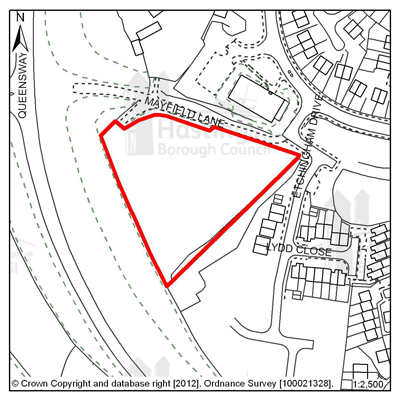
Figure 20: GH4 - Mayfield J, Mayfield Lane
Site address: Mayfield J, Mayfield Lane
Allocated use: Residential
Area: 0.77ha
Possible net capacity: 36
6.76 Site GH4 – Mayfield J, Mayfield Lane – where the suitability of developing it for housing has been established through an earlier resolution by the Planning Committee to approve a planning application subject to a legal agreement. It is allocated for residential development.
6.77 The details of the scheme, number HS/OA/07/00895, can be found at: www.ukplanning.com
6.78 HS/OA/07/00895 may help inform any discussions about future proposals on site GH4.
(1)
 Site reference: GH5 - Land at Redgeland Rise (Wishing Tree
Nursery)
Site reference: GH5 - Land at Redgeland Rise (Wishing Tree
Nursery)

Figure 21: GH5 - Land at Redgeland Rise (Wishing Tree Nursery)
Site address: Land at Redgeland Rise (Wishing Tree Nursery)
Allocated use: Residential
Area: 0.71ha
Possible net capacity: 28
6.79 Site GH5 – Land at Redgeland Rise (Wishing Tree Nursery) – where the suitability of developing it for housing has been established through an earlier resolution by the Planning Committee to approve a planning application subject to a legal agreement. It is allocated for residential development.
6.80 The details of the scheme, number HS/OA/11/00854, can be found at: www.ukplanning.com
6.81 HS/OA/11/00854 may help inform any discussions about future proposals on site GH5.
 Site reference: GH6 - Mayfield Farm
Site reference: GH6 - Mayfield Farm
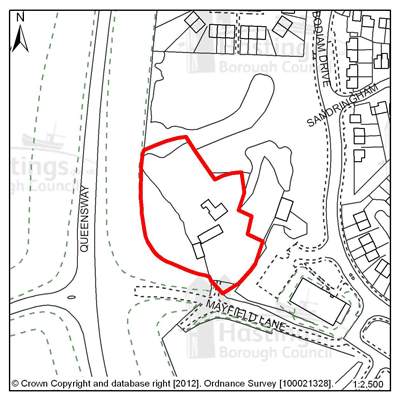
Figure 22: GH6 - Mayfield Farm
Site address: Mayfield Farm
Allocated use: Residential
Area: 0.54ha
Possible net capacity: 8
6.82 Site GH6 – Mayfield Farm - was allocated for residential development in the 2004 Local Plan. It is a gently sloping site at the edge of an existing residential area. There is the potential for this site to accommodate about 8 dwellings.
6.83 The site is adjacent to site GH2 which has a design brief that indicates that there are opportunities to connect the two sites, and this should be examined and referenced within any schemes proposed for site GH6.
6.84 Planning permissions for this site have lapsed, and the details of the lapsed permissions, numbers HS/LB/05/00156 and HS/FA/05/00157, can be found at: www.ukplanning.com
6.85 The decision made on applications HS/LB/05/00156 and HS/FA/05/00157 will inform any discussions about future proposals on site GH6. The previous permissions were for a development of three dwellings, but there is an opportunity for more than three dwellings on this site. It should also be noted that Mayfield Farmhouse, a Grade II listed building, is in the centre of this site. Any new development will need to sustain and enhance the setting of the building.
 Site reference: GH7 - Land South of 12-17 Catsfield Close
Site reference: GH7 - Land South of 12-17 Catsfield Close

Figure 23: GH7 - Land south of 12-17 Catsfield Close
Site address: Land South of 12-17 Catsfield Close
Allocated use: Residential
Area: 0.41ha
Possible net capacity: 10
6.86 Site GH7 – Land South of 12-17 Catsfield Close – where the suitability of developing it for housing has been established through an earlier resolution by the Planning Committee to approve a planning application subject to a legal agreement. It is allocated for residential development.
6.87 The details of the scheme, number HS/FA/12/00252, can be found at: www.ukplanning.com
6.88 In the event of a permission lapsing, the decision made on application HS/FA/12/00252 will inform any discussions about future proposals on site GH7.
 Site reference: GH8 - Sites PX and QX, Churchfields
Site reference: GH8 - Sites PX and QX, Churchfields
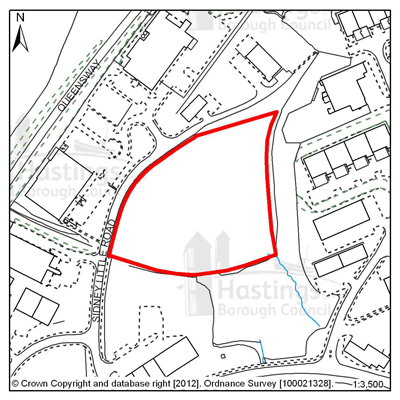
Figure 24: GH8 - Sites PX and QX Churchfields
Site address: Sites PX and QX, Churchfields
Allocated use: Employment; use class B1
Area: 1.61ha
Potential floorspace (gross): 6,900m2
6.89 Site GH8 – PX and QX, Churchfields – is the largest remaining undeveloped site on the Churchfields Employment Estate.
6.90 The site is largely open, but overgrown with scrub. It is sloping, which is a constraint on development. It is capable of accommodating a single large occupier or, more easily given the topography, several medium sizes units. The long frontage onto Sydney Little Road allows a choice of possible access points.
6.91 Trees along the southern and eastern boundaries should be safeguarded. An ecological survey of the site will be required prior to redevelopment to establish if any protected species are present.
6.92 Potential applicants should pay particular attention to policies DM1 and DM4 of this Plan. Policies DM6 and DM7 may also be of relevance. Within the Planning Strategy, transport policies T3 and T4, and environment policy EN3 are particularly applicable.
 Site reference: GH9 - NX2 Sidney Little Road, Churchfields
Site reference: GH9 - NX2 Sidney Little Road, Churchfields
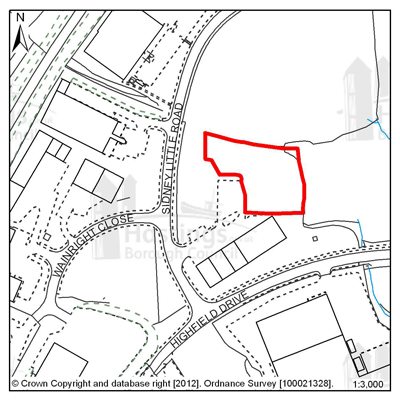
Figure 25: GH9 - NX2 Sidney Little Road, Churchfields
Site address: NX2 Sidney Little Road, Churchfields
Allocated use: Employment; use class B1
Area: 0.32ha
Potential floorspace (gross): 770m2
6.93 Site GH9 – NX2 Sidney Little Road, Churchfields – is one of a group of three small development plots. The first, NX1 immediately to the south, was developed as a row of small business units. The existing access off Sydney Little Road is configured to serve both the existing units and those still to be built on this site, NX2, and on site NX3. The slope of the site is a constraint on its development. The only other constraint that is apparent is the vegetation on and along the northern edge of the site, which should be retained where practical. As with NX1, the site is suited to a group of small units.
6.94 Potential applicants should pay particular attention to policies DM1 and DM4 of this Plan. Policy DM6 may also be of relevance. Within the Planning Strategy, transport policies T3 and T4 are particularly applicable.
6.95 NB. Planning permission was granted for 5 nursery units on this site in 2004 – ref. no. HS/FA/06/00612
 Site reference: GH10 - Site RX2, Sidney Little Road,
Churchfields
Site reference: GH10 - Site RX2, Sidney Little Road,
Churchfields
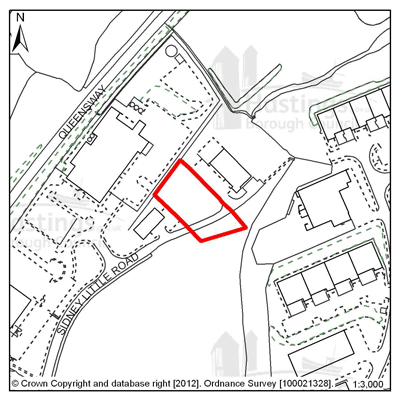
Figure 26: GH10 - Site RX2, Sidney Little Road, Churchfields
Site address: Site RX2, Sidney Little Road, Churchfields
Allocated use: Employment; use class B1
Area: 0.22ha
Potential floorspace (gross): 910m2
6.96 Site GH10 – Site RX2, Sidney Little Road, Churchfields – is a small open site that is the remaining plot of a group of three - the other two having been developed as small/medium business units some time ago.
6.97 A business unit similar in scale to those existing will be acceptable and a shared access with the unit to the north-east would be the most space efficient arrangement.
6.98 Potential applicants should pay particular attention to policies DM1 and DM4 of this Plan. Policy DM6 may also be of relevance. Within the Planning Strategy, transport policies T3 and T4 are particularly applicable.
 Site reference: GH11 - Site NX3 Sidney Little Road,
Churchfields
Site reference: GH11 - Site NX3 Sidney Little Road,
Churchfields

Figure 27: GH11 - NX3 Sidney Little Road, Churchfields
Site address: Site NX3 Sidney Little Road, Churchfields
Allocated use: Employment; use class B1
Area: 0.17ha
Potential floorspace (gross): 920m2
6.99 Site GH11 – NX3 Sidney Little Road, Churchfields – is one of a group of three small development plots. The first, NX1 immediately to the south, was developed as a row of small business units. The existing access off Sydney Little Road is configured to serve both the existing units and those to be built on this site, NX3, and on site NX2. The slope of the site is a constraint on its development. The only other constraint that is apparent is the vegetation on and along the northern edge of the site which should be retained where practical. As with NX1, the site is suited to a group of small units.
6.100 Potential applicants should pay particular attention to policies DM1 and DM4 of this Plan. Policy DM6 may also be of relevance. Within the Planning Strategy, transport policies T3 and T4 are particularly applicable.
(1) Focus Area 3: Filsham Valley and Bulverhythe
6.101 Extending from West Marina in the east and Queensway in the north, to the western boundaries of the borough, this is an area of contrast between 20th Century housing, commercial depots, and wetland nature reserves. When travelling by train from London, this is where visitors get their first impression of Hastings & St Leonards as they glimpse the sea across school playing fields and open spaces that follow the valley to the coast at Bulverhythe.
6.102 The coastal strip was the first part to be developed, along Bexhill Road. Around West Marina Gardens, housing is Victorian and Edwardian, where some of the former grandeur has faded. Recent years have seen a revival however, with much of this housing renovated. Further west, the old bathing pool site remains a development opportunity, alongside the beach chalets here and those at West Haven further along. Beyond this, the housing along Bexhill Road is generally that which was built between the wars. There are industrial areas here too and Brownfield development sites, such as the old West St Leonards school and the Bulverhythe Depot.
6.103 Inland, the housing is more modern, built mostly from the 1930s through to the late 20th Century, the most recent development on a former golf course. East of the Hastings Line railway, the houses are older, larger and mostly detached. This part of the area has a different feel; quieter, more peaceful, an urban fringe with leafy suburban streets in the east to nature reserves to the west, and surrounding countryside. The creation of the St Leonards Academy on the old Filsham Valley school site provides the potential to open the Grove School site as another development opportunity in Filsham & Bulverhythe.
6.104 There are shops scattered through Filsham & Bulverhythe, cafés and takeaways, several larger retail warehouses, a garden centre, car dealers, assorted other commercial premises, and a small community centre. This Focus Area also contains the West St Leonards railway station on the Hastings Line between Ashford in the east and London to the north.
(1) 6.105 The beach and coastline here is relatively isolated. Access to it is challenging because it is cut off from the town by the Hastings to Brighton railway line, and to some extent the A259 Bexhill Road. North of Bexhill Road, there are two important wetland nature reserves: South Saxon wetlands and Filsham Reedbeds, within the Combe Haven SSSI. There are playing fields too, and the Combe Haven holiday park, an important source of tourist accommodation.
6.106 According to 2001 Census data, 8,500 people live here and almost 50% of them are over the age of 45; this is higher than the Borough average. It is the third least deprived Focus Area of the 13 (Office of National Statistics). Census data also shows that 80% of the housing in this Focus Area is owner- occupied. The A259, Bexhill Road, dominates the southern part of the Filsham & Bulverhythe Focus Area, but with the announcement of the Bexhill-Hastings Link Road and the route options for journeys that this will bring, the congestion along this road should be reduced. Public transport options are good, and the recently completed cycle route along the seafront has created another way for people to reach Bexhill and the beach, so connectivity in this Focus Area is generally good and access to the coastline and beach is improving.
Our Vision for Filsham & Bulverhythe
6.107 Of all the Focus Areas in the borough, Filsham & Bulverhythe has the potential to see the most change. There are some larger brownfield development opportunity sites here, which could be developed as housing. Policy FA1 of the Planning Strategy identifies that this area has the potential capacity for between 630 and 700 additional homes over the next 15 years. With some of the largest sites in the borough available here, we would expect to see some innovative and imaginative uses of the land. Higher densities may well be possible, if suitably achieved with perhaps limited flatted developments. But there is a need to retain employment sites, so some existing commercial premises should be kept for employment purposes and their quality and use maintained or improved where possible.
6.108 However, the area is low-lying and in a designated ‘flood risk area’. Flood risk, and getting adequate drainage in place, is a significant challenge here.
6.109 When the Link Road is built, this will make a big difference to Bulverhythe & Filsham Valley, both along Bexhill Road and along Filsham Road. Together with the new cycle path, we would expect to see more people using the beach and sea, and tourists attracted to this area. So there is likely to be the opportunity for more facilities for them close to the beach access points: cafés, small shops, sports, and possibly licensed premises.. Consideration may be given to proposals for cafés on the beach side of the railway line. We want this part of the area to come to life, to shake off its ‘edgelands’ feel and reinvent itself. Innovation and imagination offer the potential to help maintain and strengthen the economy and community in this part of the Borough.
6.110 The former bathing pool site at West Marina remains one of the most prominent development sites on Hastings’ seafront. During the next 15 years, we expect this to be developed for both homes and leisure use. Because the site is prominent, potential schemes here would need to pay particular attention to good design and innovation, perhaps something that would be a tourist destination in itself. However, we recognise that it may be a while before such a development is viable, so innovative temporary uses for the site would be encouraged in the meantime.
(1) 6.111 The SSSI along Combe Valley will remain protected from development, beyond improved visitor facilities, although these would need to be restrained and environmentally sustainable. And we would want to retain important tourist accommodation at Combe Haven holiday park. Public playing fields and allotments elsewhere in the area will also continue to be protected.
Allocations for Filsham & Bulverhythe
| Site reference | Address | Reason for allocation (including potential number of homes) | Area (ha) | Does the site have a brief in Appendix A? |
|---|---|---|---|---|
| FB1 | The Grove School | Residential (240) | 9.40 |

|
| FB2 | Former West St Leonards Primary School | Mixed use (70) | 3.92 |

|
| FB3 | Seaside Road, West St Leonards | Mixed use (120) | 2.22 |

|
| FB4 | Former Westerleigh School | Residential (68) | 2.15 |

|
| FB5 | Former Hastings College, St Saviours Road | Residential (44) | 1.05 |

|
| FB6 | Cinque Ports Way, former Stamco timber yard & TA Centre | Mixed use (54) | 0.89 |

|
| FB7 | Former Malmesbury House, West Hill Road | Residential (117) | 0.70 |

|
| FB8 | Former Westerleigh School playing fields | Residential (7) | 0.56 |

|
| FB9 | 190 Bexhill Road | Residential (32) | 0.19 |

|
| FB10 | Land South of Crowhurst Road |
Permanent site for Gypsies and Travellers (2 pitches) |
0.17 |

|
| FB11 | St Ethelburga’s Church Hall | Residential (7) | 0.08 |

|
Table 13: Allocations for Filsham & Bulverhyth
Other Identified Sites
| Site reference | Address | Reason for identification | Area (ha) | Does the site have a brief in Appendix A? |
|---|---|---|---|---|
| FB12 | Land south of Upper Wilting Farm | Potential site for the harnessing of wind energy | 5.45 |

|
Table 14: Other identified sites for FB
(2)
 Site reference: FB1 - The Grove School
Site reference: FB1 - The Grove School
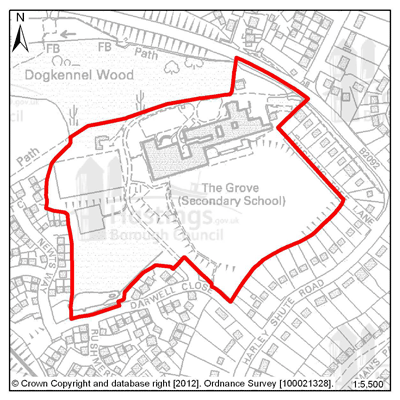
Figure 29: FB1 - The Grove School
Site address: The Grove School
Allocated use: Residential
Area: 9.40ha
Possible net capacity: 240
6.112 Site FB1 – The Grove School – will become available for development during the Plan period (up to 2028), given the changes currently taking place in secondary education in Hastings. The Council is, therefore, allocating the site for residential use.
6.113 The total site area including the woodland in the south-west corner of the site is 9.4Ha. It is assumed the wooded area would not form part of any redevelopment. If a density of 30 dwellings per hectare is assumed, the site could be capable of delivering about 240 units.
6.114 This is a large and relatively level site that gives the opportunity for a significant contribution to the delivery of housing in Hastings. The design brief for FB1 in Appendix A, shows how a development might be able to accommodate development, green space (including informal play areas), potential access points and boundary landscaping. It is intended as an example of what can be achieved and the specific details will need to be included in any resultant application. The County Council’s highway department has also suggested that development on this site will require junction improvements as shown on the design brief.
6.115 Any potential application will need to pay particular attention to policies DM1, DM3 and DM4 of this plan. The connections between any green spaces in a potential proposal will need to be clearly shown in conjunction with policy HN9. In accordance with Policy H2 of the Planning Strategy, this site may be required to include specific housing for wheelchair users and in accordance with Policy H3 Affordable Housing will be required to be provided. The policies in the Sustainable Communities chapter of the Planning Strategy should also be considered and the potential for district heating will be of particular importance for this site, so with reference to policy SC5, the Council expects the proponents of any scheme to investigate the feasibility of district heating networks and/or combined heat and power systems. Also important to consider are measures to reduce surface water flood risk, in accordance with Policy SC7, Sustainable Drainage Systems (SUDs) are likely to be required. Policy CI1 of the Planning Strategy requires that appropriate infrastructure is included with any development and, given the potential scale of development on this site, it is considered that it might be necessary to include small convenience shops to serve the development with any scheme that is proposed. Any proposal that is suggested will also need to include children’s play provision to meet the requirements of policy CI3 of the Planning Strategy.
(1)
 Site reference: FB2 – Former West St Leonards Primary School
Site reference: FB2 – Former West St Leonards Primary School
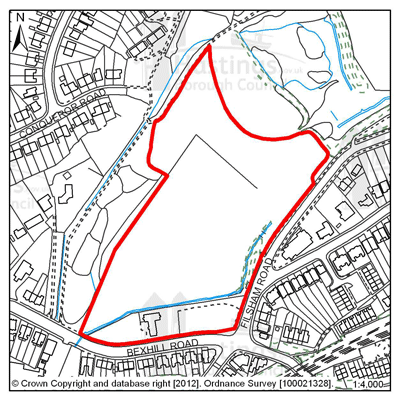
Figure 30: FB2 - Former West St. Leonards Primary School
Site address: Former West St Leonards Primary School
Allocated use: Mixed use (residential and community)
Area: 3.92ha
Possible net capacity: 70
6.116 Site FB2 – West St Leonards Primary School – was identified for mixed development including housing, open space and community uses in the 2004 Local Plan. This is a vacant site and is part of the wider West Marina redevelopment area, which is an area of vacant and under-used land the regeneration of which has been a long term objective of the Council. Previous studies have indicated that this site could support up to 70 housing units. Therefore, the site will continue to be allocated for a mix of uses including residential development with an indicative capacity of 70 units.
6.117 Housing development will be confined to the northern part of the site as indicated on the Design Brief, in Appendix A, The remainder of the site is constrained by liability to flooding and is proposed for use as formal open space and playing fields. The site is considered suitable for a low rise development of mainly family housing. The Council will expect any development to achieve high standards of sustainable design and construction. Applicants should have particular regard to policies DM1 and DM2 of this Plan and to the policies in the Sustainable Communities chapter of the Planning Strategy. Of particular importance for this site will be measures to reduce surface water flood risk and, in accordance with Policy SC7, Sustainable Drainage Systems (SUDs) are likely to be required.
6.118 The housing mix will be determined by market conditions and local housing needs at the time of development. In accordance with Policy H2 of the Planning Strategy, this site may be required to include specific housing for wheelchair users, and Affordable Housing will be required as part of the mix in accordance with policy H3. All vehicular access will be from Filsham Road. Pedestrian/cycle links are proposed to the west and south. A buffer zone is indicated on the Design Brief at the junction of Filsham Road and Bexhill Road to accommodate a bus lane.
6.119 The site adjoins the South Saxons Local Wildlife Site (LWS) to the west and north, and this nature conservation area needs to be safeguarded in the layout of the site. Part of the site was formerly a tip and may still produce landfill gas. There is also a small area of contaminated land in the north- western corner of the site. An assessment of potential contamination will therefore be required in accordance with policy DM5 of this Plan. A buffer zone should be maintained on either side of the Hollington Stream in the southern and western parts of the site. Any opportunities which arise should be taken to de-culvert other sections of the stream.
6.120 The Community Hall in the southern part of the site is nearing the end of its useful life and developers will be expected to provide a replacement building. This could be sited adjacent to the existing building.
Policy FBX - Former West St Leonards Primary School
Planning permission will be granted for a mixed use development of site FB2 (former West St Leonards Primary School) for housing, open space, including playing fields, and a replacement Community Hall. The Hall is to be provided prior to the completion of the housing development.
(1)
 Site reference: FB3 - Seaside Road, West St Leonards
Site reference: FB3 - Seaside Road, West St Leonards
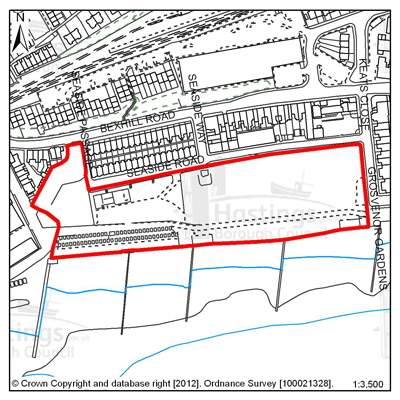
Figure 31: FB3 - Seaside Road, West St Leonards
Site address: Seaside Road, West St Leonards
Allocated use: Mixed use (residential and commercial)
Area: 2.22ha
Possible net capacity: 120
(1) 6.121 Site FB3 – Seaside Road, West St Leonards – was identified for a mixed development including housing in the 2004 Local Plan. It is a vacant brownfield site, and is part of the wider West Marina redevelopment area, which is an area of vacant and under-used land the regeneration of which has been a long term objective of the Council. Previous studies have indicated that this site could support 120 housing units as part of a mix of commercial, leisure and residential uses. Therefore the site is allocated for a mix of uses including residential development with an indicative capacity of 120 units.
6.122 Seaside Road is one of the few remaining significant re-development sites on the Hastings/St Leonards seafront. It presents an opportunity to create a high quality development which, with the adjacent Cinque Ports Way site FB6, will both regenerate the area and act as a tourist attraction in its own right, as an addition to Hastings and the Old Town. The design briefs for the two sites can be found in Appendix A. The site is capable of accommodating both apartments and family housing. The housing mix will be determined In accordance with Policy H2 of the Planning Strategy and local housing needs at the time of development. This site may be required to include specific housing for wheelchair users, and Affordable Housing will be required as part of the mix in accordance with policy H3.
6.123 The Council will expect to see a high quality innovative design with particular regard to sustainability. Applicants should have regard to policies DM1 and DM2 of this Plan and to the policies in the Sustainable Communities chapter of the Planning Strategy. The Grosvenor Gardens Conservation Area sits immediately to the east of this site. Any new development on this site must sustain and enhance the setting of the conservation area.
6.124 The location, scale and massing of housing units should have regard to the outlook of adjacent properties in Seaside Road and Grosvenor Gardens. Opportunities should be taken where possible to exploit the sea views that the site offers.
6.125 Developers will be expected to create a broad promenade for pedestrians and cyclists behind the seawall running east to west across the site. Improvements to the seawall will be required and the potential for vegetative shingle creation will need to be explored. A small area in the north-western corner of the site is liable to flooding.
6.126 The site is considered to be suitable for leisure and recreational uses, particularly those associated with the water. The site could also accommodate small scale kiosk style retail uses normally found at the seaside, a cafeteria and a public house/restaurant. These would be best sited behind the promenade. If possible, new permanent beach huts should be provided to replace the existing ones at the western end of the site. Opportunities for co-ordinating development with site FB6 should also be explored.
6.127 There is an underground tank in the northern part of the site opposite Seaside Way. This cannot be built over and must remain as open land. The eastern part of the site contains filled land and there have been previous commercial uses elsewhere on the site. Developers will be expected to provide an assessment of ground conditions and potential contamination in accordance with policy DM5 of this Plan. Vehicular access is available to Cinque Ports Way, Seaside Road and Grosvenor Gardens, and the management of these accesses and likely road and junction improvements should occur in conjunction with site FB6. Development, however, must await construction of the Bexhill-Hastings Link Road
 Site reference: FB4 - Former Westerleigh School
Site reference: FB4 - Former Westerleigh School
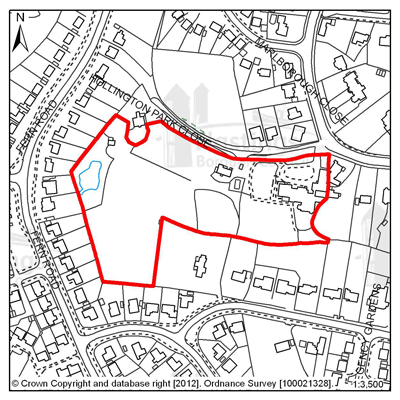
Figure 32: FB4 - Former Westerleigh School
Site address: Former Westerleigh School
Allocated use: Residential
Area: 2.15ha
Possible net capacity: 68
6.128 Site FB4 – Former Westerleigh School – provides an opportunity for redevelopment since the closure of the private school.
6.129 As a brownfield site in an established residential area, the site is allocated for residential use. The slope of the land, the existing mature trees within the site and important nature conservation issues will need to be explored in any scheme that is put forward for this site. The design brief for FB4 in Appendix A shows how a scheme might be able to accommodate development, green space, potential access points and boundary landscaping. At a density of 35 dwellings per hectare and given the areas shown on the brief that are protected, a minimum capacity of 68 dwellings could be achieved. The brief is intended as an example of what can be achieved and the specific details will need to be included in any resultant application.
6.130 Potential applicants will need to pay particular attention to Policies DM1, DM3 and DM4 of this Plan. In accordance with Policy H2 of the Planning Strategy, this site may be required to include specific housing for wheelchair users, and Affordable Housing will be required to be provided in accordance with Policy H3. Of particular importance for this site will be measures to reduce surface water flood risk, and in accordance with Policy SC7 (Planning Strategy), Sustainable Drainage Systems (SUDs) are likely to be required. Connections between the green space protected on site and those existing green spaces off site will also need to be shown on any application to ensure conformity with Policy EN2 of the Planning Strategy and HN9 of this Plan
(1)
 Site reference: FB5 - Former Hastings College, St Saviours
Road
Site reference: FB5 - Former Hastings College, St Saviours
Road
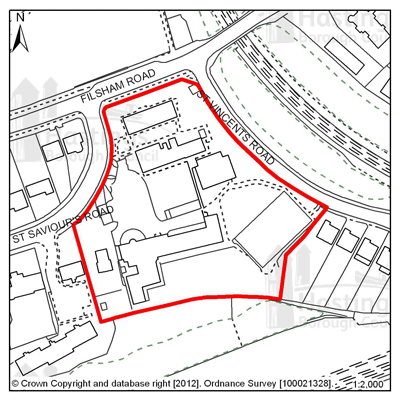
Figure 33: FB5 - Former Hastings College, St Saviours Rd
Site address: Former Hastings College, St Saviours Road
Allocated use: Residential
Area: 1.05ha
Possible net capacity: 44
6.131 Site FB5 – Former Hastings College, St Saviours Road – where the suitability of developing it for housing has been established through an earlier resolution by the Planning Committee to approve a planning application. It is allocated for residential development.
6.132 The details of the scheme, number HS/FA/09/00485, can be found at: www.ukplanning.com
6.133 In the event of a permission lapsing, the decision made on application HS/FA/09/00485 will inform any discussions about future proposals on site FB5.
(1)
 Site reference: FB6 - Cinque Ports Way, former Stamco timber
& TA Centre
Site reference: FB6 - Cinque Ports Way, former Stamco timber
& TA Centre
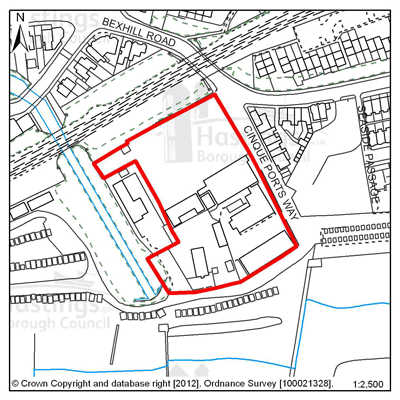
Figure 34: FB6 - Cinque Ports Way former Stamco timber and TA Centre
Site address: Cinque Ports Way, former Stamco timber & TA Centre
Allocated use: Mixed use (residential and commercial)
Area: 0.89ha
Possible net capacity: 54
6.134 Site FB6 – Cinque Ports Way, former Stamco timber & TA Centre – has redevelopment potential for a mix of uses including residential. Its seafront location also gives an opportunity for commercial and tourist development.
6.135 The site is potentially part of the West Marina redevelopment, an area of vacant and under-used land the regeneration of which has been a long term objective of the Council. Previous studies have indicated that this site could support 54 housing units as part of a mix of commercial and residential units, and these residences are the minimum for which the site is allocated.
6.136 The design brief for site FB6 (in combination with FB3) – in Appendix A – indicates how it might be organised to accommodate both commercial and residential uses. It also shows potential access routes, and the management of these accesses and likely road and junction improvements should occur in conjunction with site FB3.
6.137 There is a Public Right of Way (and the National Cycle Route) running along the southern boundary, which it will be important to link to. There is a Local Wildlife Site adjacent to FB6 to the west; and in accordance with Policy EN3 of the Planning Strategy, avoidance of harm to it is of high importance and an impact assessment will be required.
6.138 Potential applicants will need to pay particular attention to Policies DM1, DM3 and DM4 of this Plan. In accordance with Policy H2 of the Planning Strategy, this site may be required to include specific housing for wheelchair users, and Affordable Housing will be required to be provided in accordance with Policy H3. This is a site that is in a flood risk area (from all types of flooding), so in accordance with Policy SC7 of the Planning Strategy, protection and mitigation measures must be included in any scheme. Sustainable Drainage Systems (SUDs) are likely to be required. Contributions to the maintenance of the existing sea defences may also be required.
(1)
 Site reference: FB7 - Former Malmesbury House, West Hill Road
Site reference: FB7 - Former Malmesbury House, West Hill Road
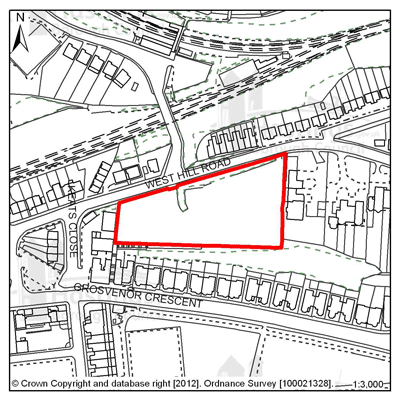
Figure 35: FB7 - Former Malmesbury House, West Hill Road
Site address: Former Malmesbury House, West Hill Road
Allocated use: Residential
Area: 0.70
Possible net capacity: 117
6.139 Site FB7 – Former Malmesbury House, West Hill Road – has a complex planning history. In 1989 planning permission was granted for the erection of 117 dwellings on the site in the form of apartment blocks (HS/OA/88/1323). In 2006, a Certificate of Lawful Use was granted stating that this development had commenced within three years of consent being granted and could therefore be completed (HS/PR/05/00980). At the same time, an appeal was dismissed following the refusal of permission for the erection of 130 apartments on the site (HS/FA/04/00700). The Inspector in his 2006 report concluded that the scheme was over intensive in terms of its scale and massing and would have a detrimental impact on adjoining dwellings.
6.140 In recent years no further work has been undertaken to implement the 1989 consent and it is therefore questionable whether it will be completed. The scheme is somewhat dated and a new scheme would provide an opportunity to incorporate the latest thinking on sustainable design and construction into this site, which the 2006 Inspector described as “an outstanding development opportunity”. Any new development should have regard to the following :-
-
The site occupies an elevated prominent location at the western end of the Grosvenor Gardens Conservation Area and is visible from a distance, particularly from the direction of the sea front. Any development should therefore respect longer distance views of the site as well as its immediate surroundings. Applicants should have particular regard to policies DM1, DM2 and HN1 of this Plan.
-
The predominant building height on this side of West Hill Road is 3 to 4 storeys. Acceptable building heights will be determined by the need to ensure that the resulting structure is not unduly dominant or over-powering when viewed from the sea front or from adjoining properties.
-
The building form in this part of West Hill Road is characterised by narrow fronted buildings with space between them. A single building of uniform mass and height would not be acceptable on this site of significant length.
-
The Council would not wish to determine the style of building(s) to be erected on the site. The important consideration is to achieve a scheme of the highest design quality, of a form and scale in character with the locality.
-
In accordance with Policy H2 of the Planning Strategy, this site may be required to include specific housing for wheelchair users, and Affordable housing will be required in accordance with Policy H3.
-
Care needs to be taken to ensure that the scale and massing of the development does not create an unacceptably overbearing impact on the two-storey dwellings opposite, the adjacent 1,2 and 3 Seaview, and Grosvenor Crescent to the south. Balconies should be carefully sited to avoid overlooking of garden areas to adjoining properties.
-
Although slow worms were translocated from the site in 2006, it has been unmanaged since. Applicants will be required to submit an ecology report in accordance with policy EN3 of the Planning Strategy.
-
The cliff to the rear of the site is a Local Wildlife Site and applicants will also be required to demonstrate that their development will not threaten the stability of the cliff in accordance with policy DM5 of this Plan.
-
There is an existing access which can be utilised. Other access points would be at the discretion of the Highway Authority.
-
The possible net capacity of 117 dwellings reflects the existing consent. The achievement of a high standard of design in keeping with the area should, however, determine the number of dwellings to be accommodated, rather than a pre-determined number of units.
(1)
 Site reference: FB8 - Former Westerleigh School, Playing
Fields
Site reference: FB8 - Former Westerleigh School, Playing
Fields

Figure 36: FB8 - Former Westerleigh School, Playing fields
Site address: Former Westerleigh School, Playing Fields
Allocated use: Residential
Area: 0.56ha
Possible net capacity: 7
6.141 Site FB8 – Former Westerleigh School, Playing Fields – where the suitability of developing it for housing has been established through an earlier resolution by the Planning Committee to approve a planning application subject to a legal agreement. It is allocated for residential development.
6.142 The details of the scheme, number HS/FA/12/00615, can be found at: www.ukplanning.com
6.143 HS/FA/12/00615 may help inform any discussions about future proposals on site FB8.
(1)
 Site reference: FB9 - 190 Bexhill Road
Site reference: FB9 - 190 Bexhill Road
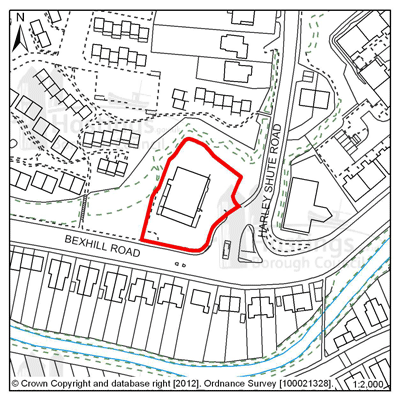
Figure 37: FB9 - 190 Bexhill Road
Site address: 190 Bexhill Road
Allocated use: Residential
Area: 0.19ha
Possible net capacity: 32
6.144 Site FB9 – 190 Bexhill Road – where the suitability of developing it for housing has been established through an earlier resolution by the Planning Committee to approve a planning application, subject to a legal agreement. It is allocated for residential development.
6.145 The details of the scheme, number HS/FA/12/00197, can be found at: www.ukplanning.com
6.146 HS/FA/12/00197 may help inform any discussions about future proposals on site FB9.
 Site reference: FB10 - Land South of Crowhurst Road
Site reference: FB10 - Land South of Crowhurst Road

Figure 38: FB10 - Land South of Crowhurst Road
Site address: Land South of Crowhurst Road
Allocated use: Permanent site for Gypsies and Travellers
Area: 0.17Ha
Possible net capacity: 2 pitches
6.147 Site FB10 – Land South of Crowhurst Road – is allocated for a permanent residential Gypsy and Traveller site, with an indicative capacity for 2 pitches.
6.148 This is a small site that is near to the Queensway, and the Queensway has connections to the wider road network. Access onto the site will need to be improved, but there is enough space to accommodate two residential pitches and ancillary buildings on site.
(1) 6.149 The site has a good tree belt at its perimeters, and the Council would wish to see this retained as far as is practicable and potential applicants will need to pay particular attention to Policies DM1, DM3 and DM4 of this Plan. The site is also close to sensitive ecological areas, so any potential scheme should demonstrate how it complies with Policy EN3 of the Planning Strategy and HN9 of this Plan.
 Site reference: FB11 - St Ethelburga’s Church Hall
Site reference: FB11 - St Ethelburga’s Church Hall
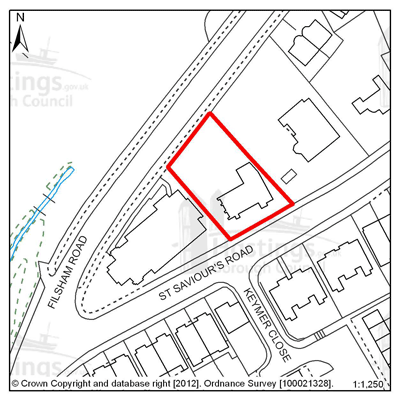
Figure 39: FB11 - St Ethelburga's Church Hall
Site address: St Ethelburga’s Church Hall
Allocated use: Residential
Area: 0.08ha
Possible net capacity: 7
6.150 Site FB11 – St Ethelburga’s Church Hall – where the suitability of developing it for housing has been established through an earlier resolution by the Planning Committee to approve a planning application; is allocated for residential development.
6.151 The details of the scheme, number HS/FA/09/00640, can be found at: www.ukplanning.com
6.152 In the event of a permission lapsing the decision made on application HS/FA/09/00640 will inform any discussions about future proposals on site FB11.
6.153 St Ethelburga’s Church is considered to be a local heritage asset. Any development on the adjacent site (FB11) should therefore aim to sustain and enhance the setting of the church.
(1)
 Site reference: FB12 - Land south of Upper Wilting Farm
Site reference: FB12 - Land south of Upper Wilting Farm
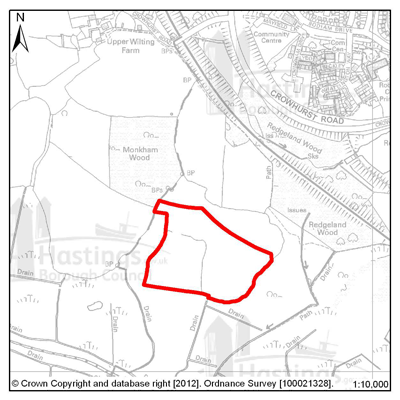
Figure 40: FB12 - Land south of Upper Wilting Farm
Site address: Land south of Upper Wilting Farm
Identified use: Potential site for the harnessing of wind energy
Area: 5.45ha
(1) 6.154 Policy SC6 of the Planning Strategy states that the Council will consult on potential sites for renewable energy. A study undertaken by Element Energy Ltd has indicated that there are some possible sites in and on the outskirts of the town where wind power could be harnessed. Sites in Hastings Country Park were originally suggested but they were within an ecologically protected area (the Hastings Cliffs Special Area of Conservation), so these were ruled out. This site in the west of the borough at the edge of the Combe Valley Countryside Park was also identified as one that was at a distance from buildings, power lines and areas of particular environmental protection where it might be possible to site wind turbines.
6.155 The Council has committed to some further investigation work on the feasibility of this site for wind turbines, in ecological, landscape and viability terms. The site is adjacent to the borough boundary, and so it is likely that any further work that is carried out in connection with this site will be in conjunction with Rother District Council.
(1) Focus Area 4: St Helens
6.156 This Focus Area is dominated by St Helen’s Wood, a local nature reserve with meadowland, woodlands, ponds and streams. To the northern end, St Helen’s Wood joins with playing fields and open spaces at The Ridge and out to the High Weald countryside beyond. The St Helens Focus Area stretches from Parker Road in the east to the Conquest Hospital, and from St Helen’s Road in the south up to the northern edge of the borough at The Ridge.
6.157 Housing in St Helens is mostly 20th Century post war, although there are Victorian terraces and larger 19th Century detached homes in the south east of the area. Elsewhere, there are a few older houses that were once more rural homes that have been overtaken by Hastings’ expansion. This is a Focus Area where there is another very eclectic range of homes and architectural styles. Around St Helen’s Wood nature reserve there are individually designed homes, with large, often wooded gardens. Away from the woods some of the housing is more modest.
6.158 Although this is primarily a residential area, St Helens is also home to William Parker School, the borough’s boys’ secondary school. There is also the cemetery and crematorium, Hastings United football stadium at the Pilot Field, the Firs former football ground, and various playing fields and allotments. St Helens is less well served by shops and employment than other Focus Areas, with most services being just over the borders into other areas. There are some individual shops, pubs and facilities but residents of St Helens often have to travel to get to their jobs and the services they need, with 2001 Census data suggesting car ownership in this area is high, which reflects this fact.
6.159 This is one of the most populous of our Focus Areas, with 11,000 inhabitants, although it is also one of the largest by area. It is the second least deprived part of the borough (ONS), and 78% of the homes are owner-occupied (according to census data). The population here is older than the borough average, with more than a third above retirement age, the second highest in the borough (2001 Census).
Our Vision for St Helens
6.160 The Planning Strategy sets out the requirement for 210-250 new homes to be built in the next 15 years; with most potential development opportunities on Elphinstone Road and The Ridge. Where new development does occur, we would expect it to be in keeping with the suburban and semi-rural nature of the area. Densities of new developments are likely to be higher than current low-density housing. Small flatted developments could be acceptable, with a mix of designs to include houses with gardens where appropriate. Social rented and affordable housing would also be encouraged here, as there’s currently little of it in this area.
6.161 In order to maintain and enhance the communities here, opportunities for mixed use development to include local services could be investigated and the inclusion of live/work units may be appropriate. We will encourage the retention of existing employment land in St Helens that is at a premium. Development proposals, particularly along The Ridge, will need to show consideration of the traffic impact onto and off locally important traffic routes.
6.162 St Helen’s Wood nature reserve will remain protected from development. Any development at the edge of St Helen’s Wood will need to be particularly sympathetic to the character of the reserve, and schemes should aim to preserve views and access to the undeveloped wooded edges. Development proposals on the main roads, and particularly The Ridge, will need to appreciate their potential impact on traffic locally, especially when the new Bexhill-Hastings Link Road is built and new regular routes through Hastings’ Borough are established.
Allocations for St Helens
| Site reference | Address | Reason for allocation (including potential number of homes) | Area (ha) | Does the site have a brief in Appendix A? |
|---|---|---|---|---|
| SH1 | Land adjacent to Sandrock Park, The Ridge | Residential (80) | 3.32 |

|
| SH2 | Land at Osborne House, The Ridge | Residential (55) | 2.97 |

|
| SH3 | Hurst Court, The Ridge | Residential (30) | 1.44 |

|
| SH4 | Mount Denys, Pinehill & Ridgeway | Residential (31) | 0.64 |

|
| SH5 | Rear of Linley Drive | Residential (15) | 0.32 |

|
| SH6 | 195 The Ridge | Residential (14) | 0.26 |

|
| SH7 | 191 The Ridge | Residential (13) | 0.15 |

|
Table 15: Allocations for St Helens
(4)
 Site reference: SH1 - Land adjacent to Sandrock Park, The
Ridge
Site reference: SH1 - Land adjacent to Sandrock Park, The
Ridge
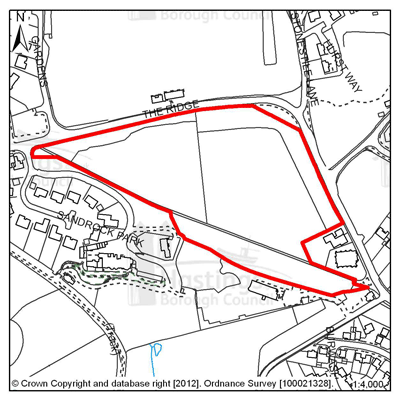
Figure 42: SH1 - Land adjacent to Sandrock Park, The Ridge
Site address: Land adjacent to Sandrock Park, The Ridge
Allocated use: Residential
Area: 3.32ha
Possible net capacity: 80
(2) 6.163 Site SH1 – Land adjacent to Sandrock Park, The Ridge – is a relatively flat triangular site that lies directly to the south of The Ridge. The western part of the site is unused and the eastern part is a playing field which is under-used.
6.164 There is a tree screen along the frontage with The Ridge. The existing boundary trees are the most significant landscape characteristic of the area, and would need to be managed as part of any development. Retention & management of the existing trees and hedges would be the primary means of mitigation. However, a new access would be required. Proposals for this site will need to include a traffic impact assessment, especially because of its close proximity to The Ridge.
6.165 This site is within an Archaeological Notification Area so any proposals put to the Council will be referred to East Sussex County Council and, in consultation with the County Archaeologist, further investigation works and/or conservation may be required.
6.166 The design brief for site SH1 – in Appendix A – indicates how it is possible to accommodate development (about 80 dwellings with a density of 30 per hectare), whilst protecting the important trees on the boundaries of the site. The site is between protected green spaces – St. Helen’s Wood Local Wildlife Site to the south and the Sandhurst recreation ground across The Ridge to the north, so it will be important that any scheme that is proposed clearly shows how links in the green infrastructure network will be retained, in accordance with Policy EN2 of the Planning Strategy. The design brief shows some suggested ways of retaining green infrastructure on site, through retaining trees, pathways and some open space which can also be used for informal recreation. The site may also require the provision of a children’s play area in accordance with policy CI3 of the Planning Strategy. The brief also shows potential access routes and that there is a Public Right of Way running through the south of the site.
6.167 Potential applicants will need to pay particular attention to Policies DM1, DM3 and DM4 of this Plan. The Ore Place conservation area covers a small part of the site in the south east, so Policy HN1 must also be considered. The site has no existing underground sewerage and will require a connection to the network. This should be included in any proposals in consultation with Southern Water. In accordance with Policy H2 of the Planning Strategy, this site may be required to include specific housing for wheelchair users, and Affordable Housing will be required to be provided in accordance with Policy H3 of the Planning Strategy.
(1)
 Site reference: SH2 - Land at Osborne House, The Ridge
Site reference: SH2 - Land at Osborne House, The Ridge
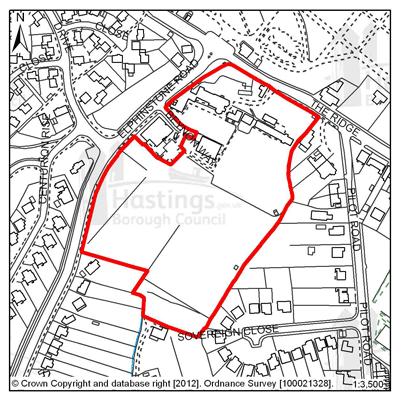
Figure 43: SH2 - Land at Osborne House, The Ridge
Site address: Land at Osborne House, The Ridge
Allocated use: Residential
Area: 2.97ha
Possible net capacity: 55
6.168 Site SH2 – Land at Osborne House, The Ridge – where the suitability of developing it for housing has been established through an earlier resolution by the Planning Committee to approve a planning application subject to a legal agreement. It is allocated for residential development.
6.169 The details of the scheme, number HS/FA/09/00179, can be found at: www.ukplanning.com
6.170 HS/FA/09/00179 may help inform any discussions about future proposals on site SH2.
(1)
 Site reference: SH3 - Hurst Court, The Ridge
Site reference: SH3 - Hurst Court, The Ridge

Figure 44: SH3 - Hurst Court, The Ridge
Site address: Hurst Court, The Ridge
Allocated use: Residential
Area: 1.44ha
Possible net capacity: 30
6.171 Site SH3 – Hurst Court, The Ridge – was allocated in the 2004 Local Plan for residential development. It is considered that the site is still suitable for such development, so the allocation will remain for about 30 dwellings.
6.172 Wildlife and tree cover are likely to affect the developable area of the site. It is therefore required that any potential scheme includes detailed ecological studies in accordance with Policy EN3 of the Planning Strategy, and that measures are put in place to protect the ecology. This site commands a prominent position on The Ridge, so any development that faces onto the road will need to be of sufficient quality and proportion to occupy such a place. Provided that these important issues can be satisfactorily addressed, the site remains suitable for residential development. Proposals for this site will need to include a traffic impact assessment, especially because of its close proximity to The Ridge.
6.173 This site is within an Archaeological Notification Area so any proposals put to the Council will be referred to East Sussex County Council and, in consultation with the County Archaeologist, further investigation works and/or conservation may be required.
6.174 The design brief for site SH3 – in Appendix A – indicates how it is possible to accommodate development and incorporate important trees and open space for informal play and recreation on the site. It will be important that any scheme that is proposed clearly shows how links in the green infrastructure network will be retained, in accordance with Policy EN2 of the Planning Strategy and with HN9 of this plan. The open space and landscaping on the brief give some guidance for this, as well as for potential access points.
6.175 Potential applicants will need to pay particular attention to Policies DM1, DM3 and DM4 of this Plan and Affordable Housing will be required to be provided in accordance with Policy H3 of the Planning Strategy.
(1)
 Site reference: SH4 - Mount Denys, Pinehill & Ridgeway
Site reference: SH4 - Mount Denys, Pinehill & Ridgeway
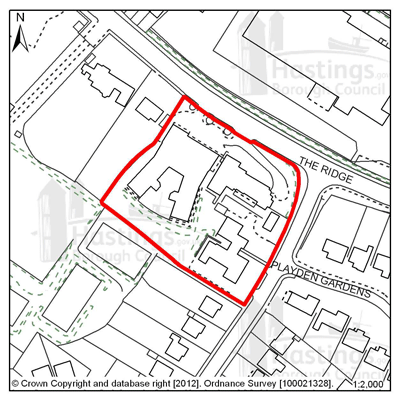
Figure 45: SH4 - Mount Denys, Pinehill & Ridgeway
Site address: Mount Denys, Pinehill & Ridgeway
Allocated use: Residential
Area: 0.64ha
Possible net capacity: 31
6.176 Site SH4 – Mount Denys, Pinehill & Ridgeway – contains buildings that are currently used by East Sussex County Council Social Services. These are likely to become vacant during the Plan period, when the services provided here are transferred to a new location and purpose-built development further along The Ridge.
6.177 Should this site be vacated, our preference would be for the site to be redeveloped for residential development. Given the existing character of the surrounding area, the site is suitable for a high density development with a suggested capacity of 31 dwellings.
6.178 The site already has some boundary treatment against The Ridge that includes grass and trees; retaining and reinforcing this should be part of any scheme submitted. East Sussex County Council has advised that increasing the amount of traffic that directly accesses The Ridge should be avoided and they would prefer that the main access to the site should be from St Helen’s Down. The County Council has also suggested that improvements might be required to the junction of The Ridge and St Helen’s Down to accommodate redevelopment on this site. Proposals for this site will need to include a traffic impact assessment, especially because of its close proximity to The Ridge.
6.179 This site is within an Archaeological Notification Area, so any proposals put to the Council will be referred to East Sussex County Council and, in consultation with the County Archaeologist, further investigation works and/or conservation may be required.
6.180 The design brief for this site – in Appendix A – highlights the access and road improvement issues and that there are some green spaces that could be retained. Potential applicants will need to pay particular attention to Policies DM1, DM3 and DM4 of this Plan, and Affordable Housing will be required to be provided in accordance with Policy H3 of the Planning Strategy.
 Site reference: SH5 - Rear of Linley Drive
Site reference: SH5 - Rear of Linley Drive
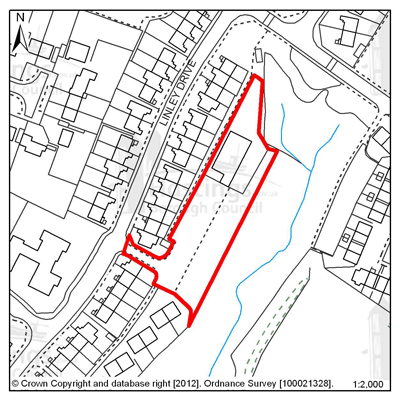
Figure 46: SH5 - Rear of Linley Drive
Site address: Rear of Linley Drive
Allocated use: Residential
Area: 0.32ha
Possible net capacity: 15
6.181 Site SH5 – Rear of Linley Drive – where the suitability of developing it for housing has been established through an earlier resolution by the Planning Committee to approve a planning application subject to a legal agreement. It is allocated for residential development.
6.182 The details of the scheme, number HS/FA/12/00215, can be found at: www.ukplanning.com
6.183 HS/FA/12/00215 may help inform any discussions about future proposals on site SH5.
 Site reference: SH6 - 195 The Ridge
Site reference: SH6 - 195 The Ridge
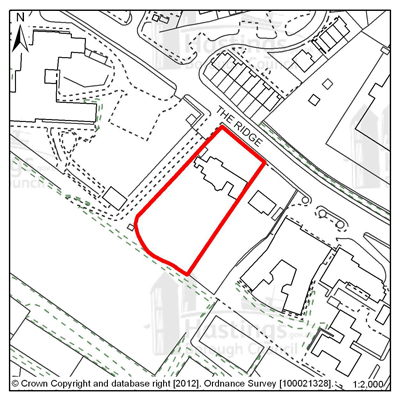
Figure 47: SH6 - 195 The Ridge
Site address: 195 The Ridge
Allocated use: Residential
Area: 0.26ha
Possible net capacity: 14
6.184 Site SH6 – 195 The Ridge – where the suitability of developing it for housing has been established through an earlier resolution by the Planning Committee to approve a planning application. It is allocated for residential development.
6.185 The details of the scheme, number HS/FA/11/00545, can be found at: www.ukplanning.com
6.186 In the event of a permission lapsing the decision made on application HS/FA/11/00545 will inform any discussions about future proposals on site SH6.
(1)
 Site reference: SH7 - 191 The Ridge
Site reference: SH7 - 191 The Ridge
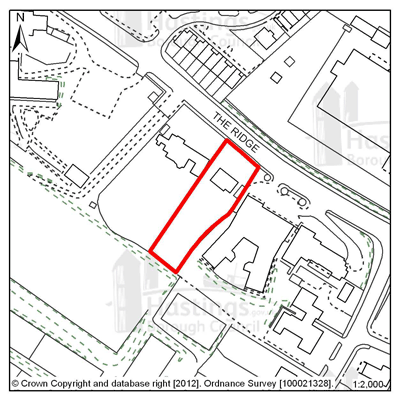
Figure 48: SH7 - 191 The Ridge
Site address: 191 The Ridge
Allocated use: Residential
Area: 0.15ha
Possible net capacity: 13
6.187 Site SH7 – 191 The Ridge – where the suitability of developing it for housing has been established through an earlier resolution by the Planning Committee to approve a planning application subject to a legal agreement. It is allocated for residential development.
6.188 The details of the scheme, number HS/OA/12/00107, can be found at: www.ukplanning.com
6.189 In the event of a permission lapsing the decision made on application HS/OA/12/00107 will inform any discussions about future proposals on site SH7.
Focus Area 5: Silverhill & Alexandra Park
6.190 From the edges of the town centre to the Silverhill shopping centre, this Focus Area follows the course of Alexandra Park, from its formal greens and gardens at the southern end to the wild and wooded reaches of Shornden and Old Roar Gill, which is a waterfall that tumbles into a narrow gorge filled with ferns and mosses.
6.191 Housing to the southern end of the area and around Silverhill centre is largely Victorian. Elsewhere, the housing is mostly inter-war, with some very elegant Art Deco houses along the edge of Alexandra Park. The area has shops and other facilities, and most of these are in the Silverhill shopping area. There are fewer of these to the south, where local people are more likely to go to Hastings Town centre for shopping, doctors and other facilities.
6.192 Employment in this Focus Area is generally centred on the Silverhill shopping centre, with a few small industrial premises, as well as retail. There is also a crop of civic buildings along Bohemia Road, including the law courts, Hastings’ principal police station, a fire station, ambulance station, some industrial units, and Horntye Sports Centre which includes Hastings cricket ground. This part of the area also includes some interesting archaeology, including an old ice house and the ‘roman baths’.
6.193 The area is characterised by urban green space: to the west, Summerfields Woods, a local nature reserve; in the south Linton Gardens; and to the east the border runs along the eastern edge of the award-winning Alexandra Park, the borough’s principal urban park. Alexandra Park includes the usual seaside attractions at the southern end, where there is a busy café, flower gardens, children’s playground, tennis courts, bowls and lakes. Further up, it becomes more natural, with woodlands and fishing lakes. The area includes Summerfields Woods, a local nature reserve in a steep-sided wooded valley, where you can find the remains of an old walled garden, now being restored. There are allotments in this area too, and other small green spaces.
6.194 In spite of all the open space, there are still over 10,000 people living in this Focus Area, with some parts, around Silverhill especially, relatively densely populated (40 people per hectare according to the 2001 Census). The age range of the population is evenly spread, displaying a mix of families with children, working age people and retirees.
6.195 The tenures in this focus area are two-thirds owner-occupation according to 2001 Census data and, in contrast to many of the other Focus Areas, there is a relatively high proportion (21%) of private rented accommodation in the Silverhill & Alexandra Park Focus Area. This last statistic could be reflective of a local population that is potentially less likely to stay in the same home as long as home owners.
Our Vision for Silverhill & Alexandra Park
6.196 This is an area dominated by protected open space: Alexandra Park, nature reserves, allotments and public playing fields. The significant public open spaces will be protected and enhanced. In particular, we would like to see better connections between Alexandra Park, Linton Gardens, Summerfields Woods, the town centre and seafront, with walking routes, cycling routes, and public transport key to this. We will encourage their use and perhaps increase community management.
6.197 Policy FA2 of the Planning Strategy plans for 300 - 360 new homes here over the next 15 years. A particular opportunity site could be at the Horntye sports centre. Given the relatively high densities of population in this Focus Area, and also the presence of Alexandra Park and other open space, potential development schemes will need to pay particular attention to innovative design solutions that address density and complement the open spaces. Opportunities to protect and enhance the connections for people and wildlife between the green spaces in this Focus Area should be fully investigated in connection with any development scheme that comes forward.
6.198 Silverhill is the commercial hub of the area, and we would expect this to remain so, and indeed to develop and improve as a retail centre. Here, there could be an opportunity for innovative design, so ideas for modern, commercial or retail development would be welcome. Away from the retail centre, Silverhill has other employment sites, and we would encourage their retention. There could be the potential to integrate appropriate employment opportunities into the more residential areas, including, for example, small workshops or live/work units.
Allocations for Silverhill & Alexandra Park
| Site reference | Address | Reason for allocation (including potential number of homes) | Area (ha) | Does the site have a brief in Appendix A? |
|---|---|---|---|---|
| SAP1 | Horntye Park | Residential (115) | 1.01 |

|
| SAP2 | Hollingsworth Garage, Braybrooke Road | Residential (56) | 0.40 |

|
| SAP3 | 12-19 Braybrooke Terrace | Residential (25) | 0.23 |

|
| SAP4 | 347-349 London Road | Residential (22) | 0.15 |

|
| SAP5 | Silver Springs Medical Practice, Beaufort Road | Residential (9) | 0.12 |

|
| SAP6 | The Langham Hotel, 16 Elphinstone Road | Residential (6) | 0.05 |

|
Table 16: Allocations for Silverhill & Alexandra Park
(1)
 Site reference: SAP1 - Horntye Park
Site reference: SAP1 - Horntye Park
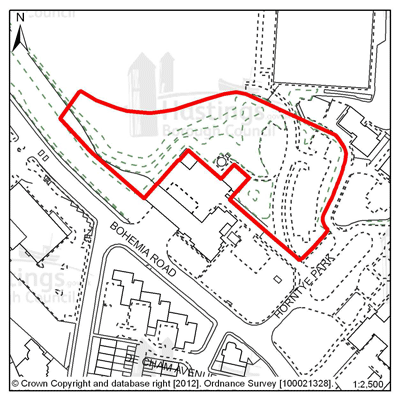
Figure 50: SAP1 - Horntye Park
Site address: Horntye Park
Allocated use: Residential
Area: 1.01ha
Possible net capacity: 115
6.199 Site SAP1 – Horntye Park – where the suitability of developing it for housing has been established through an earlier resolution by the Planning Committee to approve a planning application subject to a legal agreement, on part of the site. It is allocated for residential development.
6.200 The details of the scheme, number HS/FA/11/00334, can be found at: www.ukplanning.com
6.201 In the event of a permission lapsing the decision made on application HS/FA/11/00334 will inform any discussions about future proposals on site SAP1.
6.202 It should be noted that there is a Grade II listed ice house within this site which will need to be maintained by the site owner and/or developer. It is also required that occasional public access to the structure is provided for over the long term.
(1)
 Site reference: SAP2 - Hollingsworth Garage, Braybrooke Road
Site reference: SAP2 - Hollingsworth Garage, Braybrooke Road

Figure 51: SAP2 - Hollingsworth Garage, Braybrooke Road
Site address: Hollingsworth Garage, Braybrooke Road
Allocated use: Residential
Area: 0.40ha
Possible net capacity: 56
6.203 Site SAP2 – Hollingsworth Garage, Braybrooke Road – was allocated for residential development in the 2004 Local Plan. The site remains suitable for residential development, and is therefore allocated for residential use, with an indicative capacity of 56 dwellings.
6.204 This is a relatively narrow site that was formerly home to a motor vehicle garage, between Braybrook Road and the railway lines approaching Hastings station. The site is a prominent one, and development of it is likely to have an impact on the amenity of residents adjacent to it and across Braybrooke Road, so any scheme submitted will need to show how avoidance of adversely affecting that amenity will be achieved. The narrow nature of the site, and the fact that land levels drop away at the north-eastern end mean that access options for the site are limited, and that the on-site parking that will need to be provided may require innovative solutions, and at least a well organised and orientated scheme. The previous use of the site as a vehicle garage and workshop means that land contamination might be an issue and should be investigated by potential developers. The tree belt between the site and the railway line, mostly off-site, should also be retained.
6.205 The design brief for this site – at Appendix A – highlights the access issues and where there are some trees that should be retained. Potential applicants will need to pay particular attention to Policies DM1, DM3, DM4 and DM5 of this Plan. This site lies immediately to the south of the Blacklands Conservation Area. Any development on this site will need to sustain and enhance the setting of that Conservation Area. In accordance with Policy H2 of the Planning Strategy, this site may be required to include specific housing for wheelchair users, and Affordable Housing will be required to be provided in accordance with Policy H3.
 Site reference: SAP3 - 12-19 Braybrooke Terrace
Site reference: SAP3 - 12-19 Braybrooke Terrace
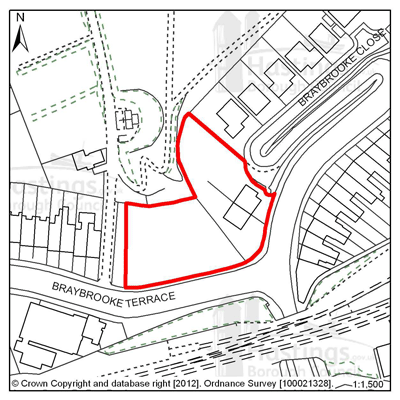
Figure 52: SAP3 - 12-19 Braybrooke Terrace
Site address: 12-19 Braybrooke Terrace
Allocated use: Residential
Area: 0.23ha
Possible net capacity: 25
6.206 Part of site SAP3 – 12-19 Braybrooke Terrace – was allocated for residential development in the 2004 Local Plan. The site remains suitable for residential development, and there is now a greater area available, so it is therefore allocated with an indicative capacity of 25 dwellings
6.207 This is a relatively narrow site that is bounded by high retaining walls and dramatic land level changes adjacent to it. Access options for the site are limited, and on site parking that will need to be provided may require innovative solutions, and at least a well organised and orientated scheme. The high retaining walls and limited rear aspect mean that the amenity of future occupants must be considered in any potential scheme; it should be demonstrated that sufficient daylight can enter all the dwellings that are proposed on site. The trees in the north of the site and adjacent to it – in Linton Gardens – should also be retained. Potential applicants should be aware that beneath the site there is a storm water retention tunnel and Southern Water will be invited to comment on any submitted proposals. It is recommended that advice is sought from Southern Water at an early stage by any potential applicant.
6.208 The design brief for this site – at Appendix A – highlights the access issues and where there are some trees that should be retained. Potential applicants will need to pay particular attention to Policies DM1, DM3 and DM4 of this Plan. Affordable Housing will be required to be provided in accordance with Policy H3 of the Planning Strategy.
 Site
reference: SAP4 - 347-349 London Road
Site
reference: SAP4 - 347-349 London Road
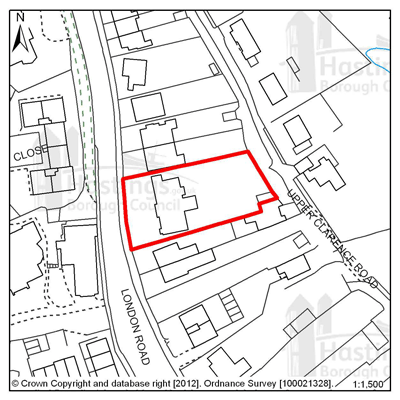
Figure 53: SAP4 - 347-349 London Road
Site address: 347-349 London Road
Allocated use: Residential
Area: 0.15ha
Possible net capacity: 22
6.209 Site SAP5 – 347-349 London Road – where the suitability of developing it for housing has been established through an earlier resolution by the Planning Committee to approve a planning application. This permission, however, has lapsed, but the site's suitability for residential development remains and therefore it is allocated for residential development.
6.210 The details of the lapsed permission, number HS/OA/08/00391, can be found at: www.ukplanning.com
6.211 The decision made on application HS/OA/08/00391 will inform any discussions about future proposals on site SAP5.
 Site
reference: SAP5 - Silver Springs Medical Practice, Beaufort
Road
Site
reference: SAP5 - Silver Springs Medical Practice, Beaufort
Road
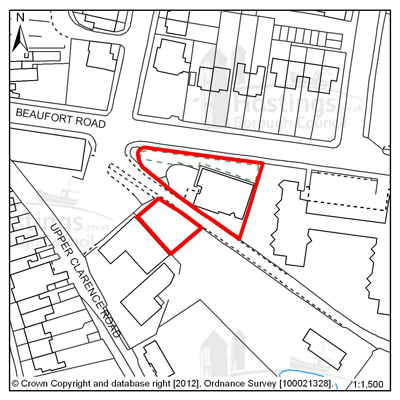
Figure 54: SAP5 - Silver Springs Medical Practice Beaufort Road
Site address: Silver Springs Medical Practice, Beaufort Road
Allocated use: Residential
Area: 0.12ha
Possible net capacity: 9
6.212 Site SAP4 – Silver Springs Medical Practice, Beaufort Road – where the suitability of developing it for housing has been established through an earlier resolution by the Planning Committee to approve an outline planning application. It is allocated for residential development.
6.213 The details of the scheme, number HS/OA/10/00845, can be found at: www.ukplanning.com
6.214 In the event of a permission lapsing the decision made on application HS/OA/10/00845 will inform any discussions about future proposals on site SAP4.
 Site
reference: SAP6 - The Langham Hotel, 16 Elphinstone Road
Site
reference: SAP6 - The Langham Hotel, 16 Elphinstone Road
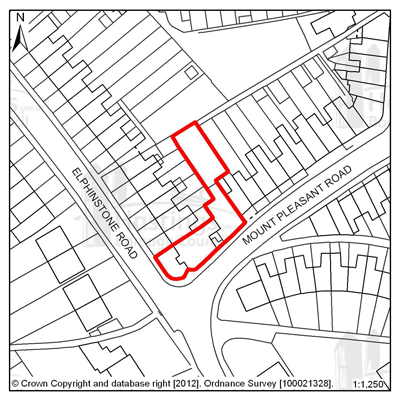
Figure 55: SAP6 - The Langham Hotel, 16 Elphinstone Road
Site address: The Langham Hotel, 16 Elphinstone Road
Allocated use: Residential
Area: 0.05ha
Possible net capacity: 6
6.215 Site SAP6 – The Langham Hotel, 16 Elphinstone Road – where the suitability of developing it for housing has been established through an earlier resolution by the Planning Committee to approve a planning application. It is allocated for residential development.
6.216 The details of the scheme, number HS/FA/12/00037, can be found at: www.ukplanning.com
6.217 In the event of a permission lapsing the decision made on application HS/FA/12/00037 will inform any discussions about future proposals on site SAP6.
6.218 It should be noted that this site is within the Blacklands Conservation Area and so the requirements of policy HN1 need to be taken into account when assessing any new proposals for this site.
Focus Area 6: Maze Hill & Burtons’ St Leonards
6.219 This area covers the ‘historic’ part of St Leonards, from the 1930s Art Deco Marine Court on the seafront, to Markwick Terrace and its surrounding streets, extending in the east from London Road to the edge of West Marina gardens. Much of Maze Hill & Burtons’ St Leonards has Conservation Area status. It is characterised by a mixture of Regency and Victorian villas and imposing terraces characterised by elegant gleaming white housing, interspersed with formal gardens at Markwick Terrace and St Leonards Gardens (one of two parks in the borough that are on the English Heritage Register of Parks and Gardens of Special Historic Interest).
6.220 Burtons’ St Leonards itself is of great architectural and townscape interest as it forms the core of the original Regency new town designed and built by James Burton and his son Decimus between1828 – 1835. Their vision included a mix of architectural styles, from Scottish baronial ‘castles’ to mock-Tudor manor houses. To the south east of the area is Mercatoria, the old ‘tradesmen’s’ area built to serve Burtons’ St Leonards. Here, houses are smaller, and have suffered from considerable neglect, although they are now improving through the general regeneration of this part of St Leonards. There are specialist shops, including antiques dealers and art galleries. The seafront here has undergone some regeneration and is slowly returning to its former 19th Century splendour. Beyond Burtons’ St Leonards and Mercatoria, to the west in particular, there is some more recent housing in small pockets, ranging from 1950s detached houses to late 20th Century terraces.
6.221 This is one of the smaller planning Focus Areas. According to 2001 Census data, just over 4,500 residents live here, and half of them are over the age of 45 (older than the average Hastings resident). There are fewer families with children in the area, with the lowest percentage of under 15 year-olds in Hastings, and a significant number of households with older people. Some of the larger houses in the area have been converted into residential homes for older people. There are a limited number of shops and other community facilities here.
6.222 2001 Census data puts population density in Maze Hill & Burtons’ St Leonards at just under 39 people per hectare. The area has parts that are more densely populated than others and this reflects the relatively small but closely built buildings towards the seafront and the larger properties further inland, as well as the green spaces in between. There is a mix of housing tenures in Maze Hill & Burtons’ St Leonards but it is dominated by two kinds, with over 70% of the homes in the Focus Area being owned by their inhabitants and, compared to other Focus Areas, a relatively high percentage being privately rented (19%).
Our vision for Maze Hill & Burtons’ St Leonards
6.223 This Focus Area is characterised by statement, often pastiche, and interesting architecture, much of which is in Conservation Areas. As such, there are certain expectations about the design and materials to be used in any potential development schemes. Early assessment and appreciation of the situation of any proposed development will be particularly important in Maze Hill & Burtons’ St Leonards, and the design and layout should be sympathetic to its surroundings. Where it is appropriate, schemes that involve a mix of housing that includes family homes will be encouraged. We are planning for 240-300 new homes to be built in the area over the next 15 years. The most significant redevelopment site in the area is at the old Hastings College site on Archery Road.
6.224 Mercatoria, which was built as the ‘commercial’ part of Burtons’ St Leonards, offers great potential to increase the number of specialist shops and artist studios for which this area of the Borough is known. Live/work units and innovative smaller projects will be encouraged, for example for artists, food retail and catering...
6.225 Elsewhere, there may be further opportunities for developing small studio-style live/work units, particularly as a way of renovating properties. The nature of this area has the potential to lend itself well to tourist accommodation, particularly in the form of small, boutique hotels and guest houses.
6.226 Along the seafront, we will continue to encourage improvements to properties. We will work with partners to promote and improve buildings to create better quality accommodation, but would want to retain the overall period look of the seafront, with the exterior of buildings restored to their original specification wherever possible.
Allocations for Maze Hill and Burtons’ St Leonards
| Site reference | Address | Reason for allocation (including potential number of homes) | Area (ha) | Does the site have a brief in Appendix A? |
|---|---|---|---|---|
| MBL1 | Former Hastings College, Archery Road | Residential (100) | 2.22 |

|
| MBL2 | 37 Charles Road West, Filsham Nurseries | Residential (9) | 0.26 |

|
| MBL3 | Gambier House, West Hill Road | Residential (15) | 0.23 |

|
| MBL4 | West Hill Road Reservoir | Residential (14) | 0.19 |

|
| MBL5 | 27 Dane Road | Residential (11) | 0.14 |

|
| MBL6 | 49-52 Caves Road | Residential (6) | 0.06 |

|
| MBL7 | 36-40 Caves Road | Residential (6) | 0.04 |

|
Table 17: Allocations for Maze Hill and Burtons' St Leonards
(1)
 Site reference: MBL1 - Former Hastings College, Archery Road
Site reference: MBL1 - Former Hastings College, Archery Road
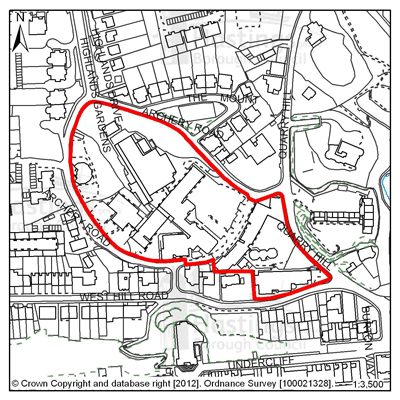
Figure 57: MBL1 - Former Hastings College Archery Road
Site address: Former Hastings College, Archery Road
Allocated use: Residential
Area: 2.22ha
Possible net capacity: 100
6.227 Site MLB1 – Former Hastings College, Archery Road – is a vacant brownfield site since the relocation of the former occupier and it is now available for redevelopment.
6.228 Redevelopment will remove the existing redundant buildings and will provide the opportunity to convert the listed buildings and introduce a new use for the remainder of the site. In terms of the volume and form of future development, key factors that need to be taken into account in any redevelopment proposals are the relationship to the terrace of listed buildings within the site and the site's location within St Leonard's West Conservation Area. Development of this site will also effect the setting of a number of listed buildings adjacent to the site boundaries and potentially three other adjacent Conservation Areas. In order to be in conformity with this plan, schemes should demonstrate how they comply with policy HN1 of this plan, and where appropriate HN2, HN3, HN4 and HN5.
6.229 Potential applicants will need to pay particular attention to Policies DM1, DM3 and DM4 of this Plan, and Affordable Housing will be required to be provided in accordance with Policy H3 of the Planning Strategy.
(1)
 Site reference: MBL2 - 37 Charles Road West (Filsham
Nurseries)
Site reference: MBL2 - 37 Charles Road West (Filsham
Nurseries)
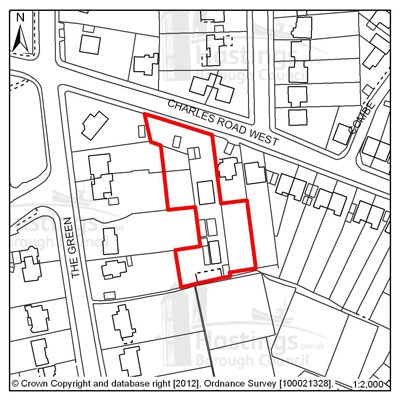
Figure 58: MBL2 - 37 Charles Road West, Filsham Nurseries
Site address: 37 Charles Road West (Filsham Nurseries)
Allocated use: Residential
Area: 0.26ha
Possible net capacity: 9
6.230 Site MBL2 – 37 Charles Road West (Filsham Nurseries) – where the suitability of developing it for housing has been established through an earlier resolution by the Planning Committee to approve a planning application subject to a legal agreement. It is allocated for residential development.
6.231 The details of the scheme, number HS/OA/06/00694, can be found at: www.ukplanning.com
6.232 HS/OA/06/00694 may help inform any discussions about future proposals on site MBL2.
 Site reference: MBL3 - Gambier House, West Hill Road
Site reference: MBL3 - Gambier House, West Hill Road
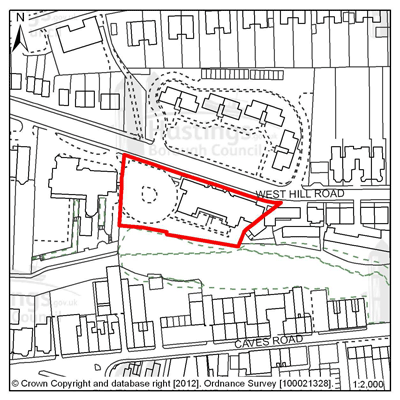
Figure 59: MBL3 - Gambier House, West Hill Road
Site address: Gambier House, West Hill Road
Allocated use: Residential
Area: 0.23ha
Possible net capacity: 15
6.233 Site MBL3 – Gambier House, West Hill Road – was allocated for residential development in the 2004 Local Plan. The existing buildings were vacated by the NHS in July 2011, and the site is therefore allocated with an indicative capacity of 15 dwellings.
6.234 The site is located within a Conservation Area and has a prominent position on the cliff top. In accordance with Policy HN1 of this plan, the retention of the ‘Gambier House’ building is preferred, and any scheme involving its demolition will need to robustly demonstrate the reasoning behind such a proposal (Policy HN3). The site has an existing access point that should be taken advantage of and this is displayed on the design brief for the site, in Appendix A.
6.235 Potential applicants will need to pay particular attention to Policies DM1, DM3 and DM4 of this Plan, and Affordable Housing will be required to be provided in accordance with Policy H3 of the Planning Strategy.
 Site reference: MBL4 - West Hill Road Reservoir
Site reference: MBL4 - West Hill Road Reservoir
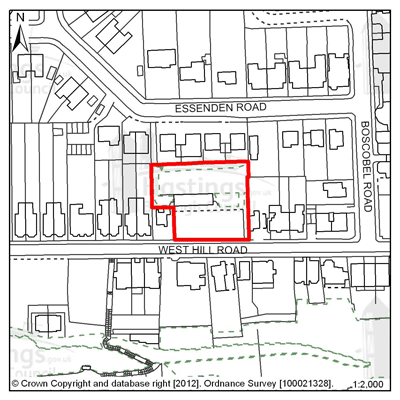
Figure 60: MBL4 - West Hill Road Reservoir
Site address: West Hill Road Reservoir
Allocated use: Residential
Area: 0.19ha
Possible net capacity: 14
6.236 Site MBL4 – West Hill Road Reservoir – where the suitability of developing it for housing has been established through an earlier resolution by the Planning Committee to approve a planning application. It is allocated for residential development.
6.237 The details of the scheme, number HS/FA/09/00663, can be found at: www.ukplanning.com
6.238 In the event of a permission lapsing, the decision made on application HS/FA/09/00663 will inform any discussions about future proposals on site MBL4.
6.239 It should be noted that this site is within the Grosvenor Gardens Conservation Area and any new development proposal on this site will be assessed in accordance with policy HN1 and where appropriate HN2, HN3 and H N4.
 Site reference: MBL5 - 27 Dane Road
Site reference: MBL5 - 27 Dane Road
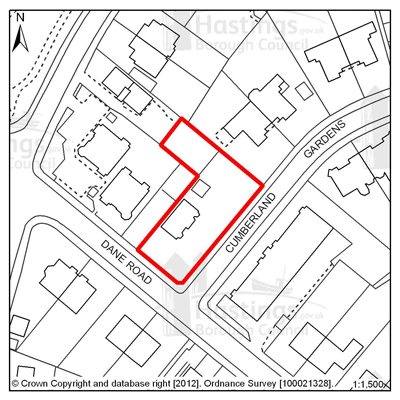
Figure 61: MBL5 - 27 Dane Road
Site address: 27 Dane Road
Allocated use: Residential
Area: 0.14ha
Possible net capacity: 11
6.240 Site MBL5 – 27 Dane Road – where the suitability of developing it for housing has been established through an earlier resolution by the Planning Committee to approve a planning application. It is allocated for residential development.
6.241 The details of the scheme, number HS/FA/08/00527, can be found at: www.ukplanning.com
6.242 In the event of a permission lapsing, the decision made on application HS/FA/08/00527 will inform any discussions about future proposals on site MBL5.
6.243 It should be noted that this site is within the Markwick Terrace Conservation Area. Any new development proposals will be assessed in accordance with policy HN1 and where appropriate HN2, HN3, HN4 and HN5.
 Site reference: MBL6 - 49-52 Caves Road
Site reference: MBL6 - 49-52 Caves Road
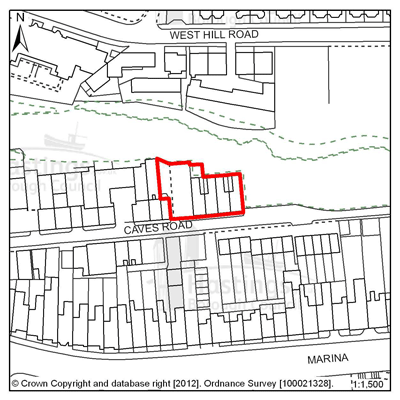
Figure 62: MBL6 - 49-52 Caves Road
Site address: 49-52 Caves Road
Allocated use: Residential
Area: 0.06ha
Possible net capacity: 6
6.244 Site MBL6 – 49-52 Caves Road – where the suitability of developing it for housing has been established through an earlier resolution by the Planning Committee to approve a planning application. This permission, however, has lapsed, but the site's suitability for residential development remains and therefore it is allocated for residential development.
6.245 The details of the lapsed permission, number HS/FA/07/00947, can be found at: www.ukplanning.com
6.246 The decision made on application HS/FA/07/00947 will inform any discussions about future proposals on site MBL6. It should be noted that this site is adjacent to a Local Wildlife Site so any new scheme should demonstrate how it complies with Policy EN3 of the Planning Strategy and with HN9 of this Plan.
6.247 It should be noted that this site is within the Grosvenor Gardens Conservation Area. Any new development proposals will be assessed in accordance with policy HN1 and where appropriate HN2, HN3, HN4 and HN5.
 Site reference: MBL7 - 36-40 Caves Road
Site reference: MBL7 - 36-40 Caves Road
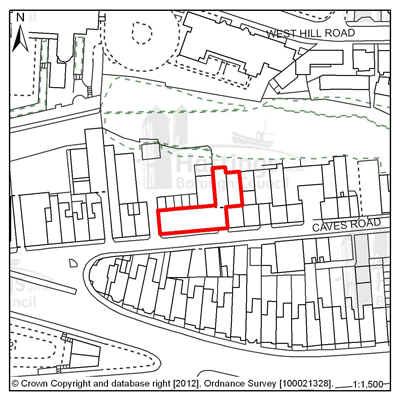
Figure 63: MBL7 - 36-40 Caves Road
Site address: 36-40 Caves Road
Allocated use: Residential
Area: 0.04ha
Possible net capacity: 6
6.248 Site MBL7 – 36-40 Caves Road – where the suitability of developing it for housing has been established through an earlier resolution by the Planning Committee to approve a planning application. It is allocated for residential development.
6.249 The details of the scheme, number HS/PR/12/00486, can be found at: www.ukplanning.com
6.250 In the event of a permission lapsing, the decision made on application HS/PR/12/00486 will inform any discussions about future proposals on site MBL7.
6.251 It should be noted that this site is within the Grosvenor Gardens Conservation Area. Any new development proposals will be assessed in accordance with policy HN1 and where appropriate HN2, HN3, HN4 and HN5.
Focus Area 7: Central St Leonards & Bohemia
6.252 Extending from White Rock gardens in the east to Grand Parade in the west, and inland to the Bohemia road shopping area, this is the most densely populated part of the borough, with approximately 85 people per hectare and almost 9,500 residents. It is also the second most economically deprived (ONS) with almost 20% of the working age population claiming Job Seekers Allowance (Department of Work and Pensions – Nomis statistics).
6.253 In spite of the high population density, there are some significant open spaces, notably Warrior Square with its formal seaside planting, White Rock Gardens, and Gensing Gardens. St Leonards Warrior Square railway station is here too, at the heart of the shopping centre. Housing here is mostly terraced and Victorian, with many Houses in Multiple Occupation (HMO). The employers here are predominantly shops and public sector employers, such as the Revenues & Customs and Social Services offices at Ocean House.
6.254 After the waning of its Victorian heydays, Central St Leonards & Bohemia have begun to change. Around St Leonards Town Centre and the seafront, significant regeneration has taken place. Many derelict properties along the seafront have been refurbished, and a new health centre has been built on the site of the long-derelict Marlborough Hotel. More recently, new ‘boutique’ hotels have opened, nationally promoted as fashionable places to stay. Around St Leonards centre, some of the narrow streets adjacent to Mercatoria, in the Gensing Farm area, have seen an up-lift, with owners refurbishing previously run-down properties. And the shopping centre itself is changing fast, with an influx of new cafés, restaurants and shops signalling significant new investment in many of the shopping streets.
6.255 This is also an ethnically diverse part of town, with many different nationalities represented. This has led to the opening of many niche shops, cafés and restaurants to meet the needs of these particular parts of the community, and these attract visitors to the area. This trend is contributing to the positive regeneration of the Focus Area.
Our Vision for Central St Leonards & Bohemia
6.256 The regeneration of this area has begun, but it is only a start. We need to encourage new businesses to the area, retail in particular. However, tourist accommodation in the shape of more ‘boutique’ hotels particularly along the seafront is important. Other businesses in the creative sector would especially fit in well with the mix and atmosphere of this area. So we will do all we can to encourage small businesses, and work with them to promote and establish themselves. We expect St Leonards centre to become a focus for independent and niche shops, cafés and restaurants, something that serves the local community as well as being a tourist attraction. This is something that we will investigate through the potential for a cultural quarter in this area promoting joint working between the Local Authority, business owners and the local community.
(1) 6.257 Policy FA2 of the Planning Strategy indicates a range of 240-300 new homes to be planned for here over the next 15 years. This is a town centre where flats and small terraced houses can provide low-priced starter homes for younger residents. We will expect these to be of innovative design, creating good quality homes, with a mix of ownership, rented and affordable housing. Bringing empty housing back into use will also contribute to the new homes totals.
6.258 The seafront will also continue to improve, becoming more of a tourist destination and connecting with St. Leonards centre. As well as using enforcement powers to get property owners to improve their buildings, we will investigate and encourage, where appropriate, quality conversions of properties to visitor accommodation, particularly along the seafront. To retain the character of the seafront we will be encouraging restoration rather than replacement of properties, at least externally. The Council-owned seafront structures, especially ‘Bottle Alley’ will also need major refurbishment. We anticipate that changes here will mean the creation of catering and retail spaces on the seafront, and will do all we can to encourage local businesses to take up these opportunities.
6.259 To the north of the area around the Bohemia shopping centre, the decline of the retail centre needs to be managed. We will investigate the possibilities here, including retail, catering, workshops, live/work units, or even conversions back into residential properties.
Allocations for Central St Leonards & Bohemia
| Site reference | Address | Reason for allocation (including potential number of homes) | Area (ha) | Does the site have a brief in Appendix A? |
|---|---|---|---|---|
| CLB1 | 1-3 Chapel Park Road | Residential (27) | 0.13 |

|
| CLB2 | Taxi office/B.R. Social Club, St Johns Road | Mixed use (30) | 0.12 |

|
| CLB3 | Sorting Office site, Kings Road | Residential (8) | 0.05 |

|
| CLB4 | 4-5 Stockleigh Road | Residential (12) | 0.03 |

|
Table 18: Allocations for Central St Leonards & Bohemia
Other Identified Sites
| Site reference | Address | Reason for identification | Area (ha) | Does the site have a brief in Appendix A? |
|---|---|---|---|---|
| CLB5 | Former Convent of Holy Child Jesus, Magdalen Road | Enabling development to preserve a heritage asset | 4.93 |

|
Table 19: Other identified sites for CLB
(6)
 Site reference: CLB1 - 1-3 Chapel Park Road
Site reference: CLB1 - 1-3 Chapel Park Road
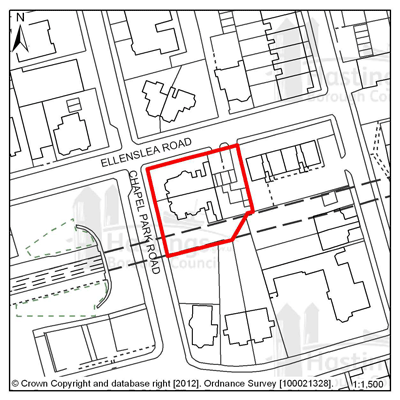
Figure 65: CLB1 - 1-3 Chapel Park Road
Site address: 1-3 Chapel Park Road
Allocated use: Residential
Area: 0.13ha
Possible net capacity: 27
(5) 6.260 Site CLB1 – 1-3 Chapel Park Road – where the suitability of developing it for housing has been established through the approval of a planning application. This permission, however, has lapsed, but the site's suitability for residential development remains and therefore it is allocated for residential development.
6.261 The details of the lapsed permission, number HS/DS/09/00133, can be found at: www.ukplanning.com
6.262 The decision made on application HS/DS/09/00133 will inform any discussions about future proposals on site CLB1. It should be noted that proposals for this site will need to take account of its likely impact upon the Kings Road Conservation Area in accordance with policy EN1 of the Planning Strategy and with HN1 of this plan.
(10)
 Site reference: CLB2 - Taxi Office/B.R. Social Club, St Johns
Road
Site reference: CLB2 - Taxi Office/B.R. Social Club, St Johns
Road
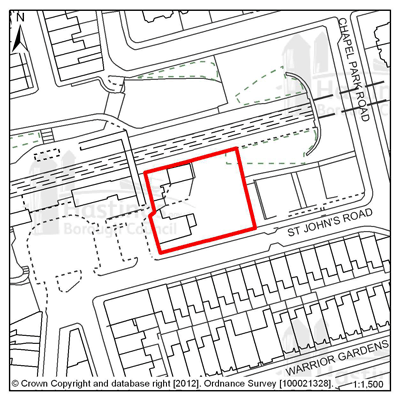
Figure 66: CLB2 - Taxi Office/B.R. Social Club, St John's Road
Site address: Taxi Office/B.R. Social Club, St Johns Road
Allocated use: Mixed Use
Area: 0.12ha
Possible net capacity: 30
(3) 6.263 Site CLB2 – Taxi Office/B.R. Social Club, St Johns Road – was allocated in the 2004 Local Plan for mixed use development, with commercial uses on the ground floor and residential above. This site is allocated for a mixed use development with an indicative capacity of 30 housing units.
(1) 6.264 The site, which is illustrated on the accompanying Design Brief – in Appendix A – presents a rare opportunity to create a landmark building which would act as a catalyst for the broader regeneration of Central St Leonards. The scale of the development will be determined by its relationship to adjacent uses and by the principles of good design and, at this stage, it is not proposed to stipulate building heights. Located within the Kings Road Conservation Area, any new development would need to be of a high quality complementing the existing urban form.
6.265 Key design factors that will need to be taken into account by applicants include the way in which the design will enhance the architectural value of the existing urban form and existing buildings within the Conservation Area, in accordance with Policy HN1. Specific importance is attached to the relationship with the existing buildings along St John’s Road, particularly in regard to privacy and overlooking. The relationship with the attractive station buildings to the west is also important.
(3) 6.266 The Council wishes to see a vibrant active street level frontage to the Station Forecourt and St John’s Road. Commercial uses will be confined to the ground floor, but can include retail and similar uses such as coffee shops/sandwich bars. The housing to be provided on the upper floors will be required to provide Affordable Housing in accordance with policy H3 of the Planning Strategy. Although the possible net capacity is set at 30 dwelling units, consideration would be given to a larger number, if the development met the criteria set out above. Of particular importance for this site, however, will be measures to reduce surface water flood risk, in accordance with Policy SC7, and Sustainable Drainage Systems (SUDs) are likely to be required. Also, given the previous uses of this site, it is likely that surveys will be required of the ground conditions for any potential contamination.
6.267 No vehicular access will be permitted from the Station Forecourt. All vehicular access will be from St John’s Road.
(2)
 Site reference: CLB3 - Sorting Office site, Kings Road
Site reference: CLB3 - Sorting Office site, Kings Road
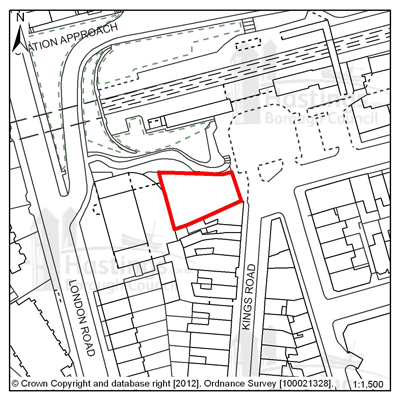
Figure 67: CLB3 - Sorting Office Site, Kings Road
Site address: Sorting Office site, Kings Road
Allocated use: Mixed use (commercial with residential above)
Area: 0.05ha
Possible net capacity: 8
(1) 6.268 Site CLB3 – Sorting Office site, Kings Road – where the suitability of developing it for housing with a commercial unit on the ground floor has been established through an earlier resolution by the Planning Committee to approve a planning application. It is allocated for a mixed use residential development.
6.269 The details of the scheme, number HS/FA/10/00102, can be found at: www.ukplanning.com
6.270 In the event of a permission lapsing the decision made on application HS/FA/10/00102 will inform any discussions about future proposals on site CLB3.
6.271 It should be noted that this site is within the Kings Road Conservation Area. Any new development proposals will be assessed in accordance with poicy HN1 and where appropriate HN2, HN3, HN4 and HN5.
 Site reference: CLB4 - 4-5 Stockleigh Road
Site reference: CLB4 - 4-5 Stockleigh Road
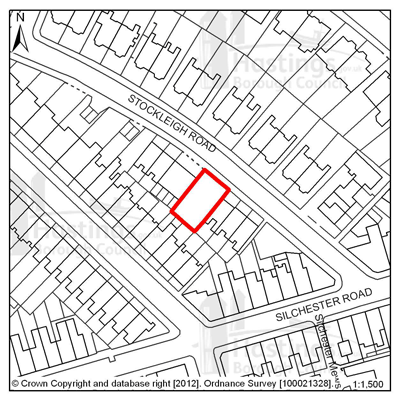
Figure 68: CLB4 - 4-5 Stockleigh Road
Site address: 4-5 Stockleigh Road
Allocated use: Residential
Area: 0.03ha
Possible net capacity: 12
6.272 Site CLB4 – 4-5 Stockleigh Road – where the suitability of developing it for housing has been established through an earlier resolution by the Planning Committee to approve a planning application. It is allocated for residential development.
6.273 The details of the scheme, number HS/FA/10/00344, can be found at: www.ukplanning.com
6.274 In the event of a permission lapsing the decision made on application HS/FA/10/00344 will inform any discussions about future proposals on site CLB4.
6.275 It should be noted that this site is within the St Leonards North Conservation Area. Any new development proposals will be assessed in accordance with poicy HN1 and where appropriate HN2, HN3, HN4 and HN5.
(16)
 Site reference: CLB5 – Former Convent of Holy Child Jesus,
Magdalen Road
Site reference: CLB5 – Former Convent of Holy Child Jesus,
Magdalen Road

Figure 69: CLB5 - Former Convent of Holy Child Jesus, Magdalen Rd
Site address: Former Convent of Holy Child Jesus, Magdalen Road
Identified use: Enabling development to preserve a heritage asset
Area: 4.93ha
(2) 6.276 The current owners have suggested that they may vacate and dispose of this site. In recent years it has been used as a summer language school. The site includes a number of listed buildings many of which are in need of repair. Allowing these buildings to become vacant and to deteriorate further represents a wasted resource. The Council wants to see as many as possible of the historically important buildings sympathetically converted and re-used. There may be a number of acceptable uses for the site; the key issue for the Council will be whether a specific proposal will be able to fund the repair and maintenance of the listed buildings.
6.277 In an established residential area, one option would be for the conversion of the listed buildings to residential use (with the exception of the Grade II* Chapel building, for which see below). Based on current information, the Council considers that the Priory, the Gothic Building, the Gate Lodge and the former Convent Building could be converted so as to provide approximately 32 dwellings.
(1) 6.278 Any development of this site will need to secure the restoration and long term future of the historic buildings. This will include the restoration and ongoing maintenance of the Grade II* listed Chapel building which is not capable of being converted but is a nationally important building.
(2) 6.279 As a last resort this could be achieved by means of enabling development. Enabling development is development that would be unacceptable in planning terms but for the fact that it would bring public benefits sufficient to justify it being carried out, and which could not otherwise be achieved. Enabling development is an established and useful planning tool by which a community may, after all other solutions have been explored, be able to secure the long term future of a place of heritage significance, and sometimes other public benefits, provided it is satisfied that the balance of public advantage lies in so doing. The public benefits are funded through the increased value of the land as a result of the grant of planning permission for its development.
6.280 In this case, because of the national importance of the site (a unique collection of Grade II* and II buildings), ‘community’ and ‘public interest’ must be considered in the widest sense. The public gain would be the repair and conservation of the heritage assets for the long term and the amelioration of the harmful impact on the character and appearance of the area that is caused by the buildings’ current poor condition. The dis-benefit would be the approval of built development that would otherwise be unacceptable in planning terms. Permission would only be granted if the public benefits can be shown to outweigh the dis-benefits of the scheme.
(8) Policy CLBX – Former Convent of Holy Child Jesus, Magdalen Road
The Council will only grant planning permission for development within the curtilage of the Former Convent of Holy Child Jesus which secures the long term future of the existing buildings.
The Council will only approve enabling development where the proposal in question:
-
secures the long term future of all of the listed former Convent buildings including boundary walls and structures of those walls;
-
secures the ongoing management of the whole of the site as a single entity and as a place of special significance;
-
is, subject to the need to provide affordable housing (for which see below), the minimum amount of development required to secure the long term future of the existing buildings and the site as a whole ;
-
follows genuine investigation of the potential for securing the long term future of the buildings without the need for enabling development and the exploration of unrestricted disposal on the open market;
-
can be shown to be the only realistic source of sufficient subsidy to secure the long term future of the buildings;
-
provides an appropriate amount of affordable housing (for which see Policy H3 of the Planning Strategy), even if this increases the overall number of units to be provided; and where
-
the public benefit of securing the future of the heritage assets through such enabling development decisively outweighs the dis-benefits of the harm otherwise caused by the scheme.
In addition, planning permission will only be granted for enabling development if:
-
the impact of the development is precisely defined at the outset, through the granting of full, rather than outline, planning permission;
-
the achievement of the heritage objective is secured through the use of a Section 106 agreement or other enforceable means;
-
the heritage assets concerned are repaired to an agreed standard, or the funds to do so made available, as early as possible in the course of the enabling development, and in any event, before completion or occupation of any new build;
The Planning Authority will closely monitor implementation, if necessary acting promptly to ensure that obligations are fulfilled.
(1) Focus Area 8: Hastings Town Centre
6.281 This Focus Area is the commercial and retail heart of the borough, extending from the Old Town in the east to White Rock in the west, and inland as far as Summerfields Wood and the Hastings Line railway between London and Ashford. Most of the town’s comparison retail trade takes place here, and the tightly constrained physical boundaries of Hastings have generally prevented the development of out-of-town shopping.
6.282 Hastings Town Centre has a good representation of national high street retail, catering and other business chains and there are also many independent shops, cafés and bars. The latter are predominantly in the traditional shopping areas along Robertson Street, Queens Road, and in St Andrew’s Square and Queens Arcade. Morrisons supermarket also occupies a significant part of this Focus Area. Many of the shops in Hastings Town Centre are Victorian, although newer buildings have replaced them in some areas, notably in the modern Priory Meadow shopping centre, where the Victorian cricket ground on which it stands is remembered with the bronze sculpture of a batsman.
6.283 The architecture of Hastings Town Centre takes on many forms and patterns. There are Victorian terraces; mid 20th Century retail blocks and very recent retail, office and educational developments. There are also many separate and distinct buildings including Pelham Crescent, St Mary in the Castle and the Brassey Institute. There are also lesser know gems too, such as the Victorian warehouses along Duke Street. This is another Focus Area where eclectic architecture has, and continues to, help define its character. There are tourist attractions, such as the White Rock Theatre, Hastings Museum and Art Gallery, and the seafront itself. And there are residential areas too, predominantly around St Andrew’s Square, Wellington Square and Holmsdale Gardens.
6.284 Significant regeneration has taken place, notably the Lacuna Place development and 1 Priory Square, Sussex Coast College, the improved railway station, a new health centre and the Hastings campus of the University of Brighton. Major improvements to the seafront through ‘grotbuster’ enforcement action, with many of the formerly derelict seafront buildings now refurbished and back in use, have also occurred. But significant regeneration challenges remain: White Rock Baths, the Observer Building, and Hastings Pier all remain out of use, although the pier does now have a hopeful future, thanks to the Hastings Pier and White Rock Trust.
6.285 Around 3,500 people live in Hastings Town Centre (according to 2001 Census data), and these are predominantly young adults. Almost 50% of the houses in this Focus Area are owned by their occupants. However, a relatively high proportion (38%) of homes are privately rented and a number of them are Homes in Multiple Occupancy, which suggests a relatively transient population. Around a fifth of the working age population of this Focus Area is in receipt of Job Seeker’s Allowance (Department of Work and Pensions – Nomis statistics). The residents are able to access a high level of services and facilities: doctors, dentists, a library and more, all within the Town Centre, but the good public transport connections, especially at Hastings’ railway station and the adjoining bus interchange, provide the opportunity to travel further afield.
Our Vision for Hastings Town Centre
6.286 Conservation Areas cover much of the Hastings Town Centre Focus Area, and because of this, there are extra guidelines over what form development can take. It will be important for many features of the Focus Area to be preserved and enhanced; nevertheless there are still considerable redevelopment opportunities where innovation and excitement can prevail. Consideration will be given to the appropriate inclusion of taller buildings.
6.287 Outlined in the Planning Strategy (Policy FA2) is the potential for another 20,500 square metres of comparison retail floor space, and this should be accommodated within the Town Centre boundary, so redevelopment opportunities could be suggested.
6.288 In particular, we want to see the development of Priory Quarter continued, including the rest of Havelock Road north of Lacuna Place, Queensbury House, and Priory Street, to create employment, retail and leisure uses. The Observer Building needs to be brought back into use too.
6.289 There are opportunities in Hastings Town Centre for residential development – town centres are a good location for homes, particularly good-quality flats that can also serve as starter homes for young people. Introducing new housing into town centres can improve the balance and ‘feel’ of a place, especially at night. Policy FA2 of the Planning Strategy sets the range of new homes provided in Hastings Town Centre over the next fifteen years at 200 - 240.
6.290 Improvement and refurbishment of some of the residential areas and tourist accommodation has begun in the Focus Area and we will encourage the continuation and expansion of this, where appropriate, across Hasting Town Centre.
6.291 On the seafront, we expect to see Hastings Pier and White Rock Baths brought back into use. We will do all we can to help Hastings Pier and White Rock Trust build a modern, regenerated pier, and will help the Foreshore Trust get White Rock Baths back in use, with possible temporary uses for the upper parts initially. Further east, we anticipate that the seafront will continue to be used for leisure and catering purposes, although would hope to see these further developed and improved.
Allocations for Hastings Town Centre
| Site reference | Address | Reason for allocation (including potential number of homes) | Area (ha) | Does the site have a brief in Appendix A? |
|---|---|---|---|---|
| HTC1 | Hastings Station Yard (part) | Residential (27) | 0.44 |

|
| HTC2 | Cornwallis Street Car Park | Residential (10) | 0.22 |

|
| HTC3 | The Observer Building (part) | Mixed use (39) | 0.07 |

|
| HTC4 | 40 & 41 Wellington Square | Residential (12) | 0.02 |

|
| HTC5 | 36 & 37 Wellington Square | Residential (12) | 0.02 |

|
Table 20: Allocations for Hastings Town Centre
Employment Allocations
| Site reference | Address | Potential gross floorspace (m2) | Area (ha) | Does the site have a brief in Appendix A? |
|---|---|---|---|---|
| HTC6 | Priory Quarter, Havelock Road | 21,700 | 2.60 |

|
Table 21: Employment allocations for HTC
(1)
 Site reference: HTC1 - Hastings Station Yard (part)
Site reference: HTC1 - Hastings Station Yard (part)

Figure 71: HTC1 - Hastings Station Yard (Part)
Site address: Hastings Station Yard (part)
Allocated use: Residential
Area: 0.44ha
Possible net capacity: 27
6.292 Site HTC1 – Hastings Station Yard (part) – where the suitability of developing it for housing has been established through an earlier resolution by the Planning Committee to approve a planning application. It is allocated for residential development.
6.293 The details of the scheme, number HS/FA/06/00983, can be found at: www.ukplanning.com
6.294 HS/FA/06/00983 will inform any discussions about future proposals on site HTC1.
 Site reference: HTC2 - Cornwallis Street car park
Site reference: HTC2 - Cornwallis Street car park
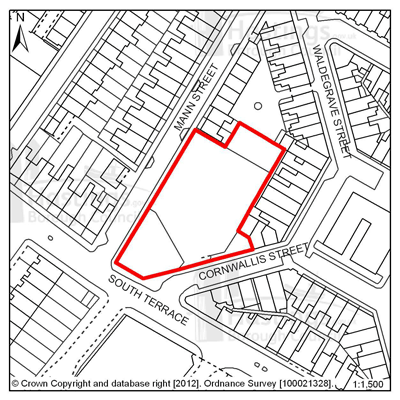
Figure 72: HTC2 - Cornwallis Street Car Park
Site address: Cornwallis Street car park
Allocated use: Residential
Area: 0.22ha
Possible net capacity: 10
6.295 Site HTC2 – Cornwallis Street car park – was allocated in the 2004 Local Plan. Its suitability for residential development remains and it is therefore allocated with an indicative capacity of 10 dwellings.
6.296 This site is in a town centre location near to other residential properties and it has an existing access route that should be taken advantage of. Development proposals of this site for residential use will need to include an assessment of the impact upon parking provision in Hastings town centre, and if appropriate, measures to secure continued public access parking either on site or elsewhere. Any scheme will be expected to investigate the inclusion of play space alongside residential development in this area where there is a current deficiency, in accordance with Planning Strategy policies CI1 and CI3.
6.297 Potential applicants will need to pay particular attention to Policies DM1, DM3 and DM4 of this Plan. In accordance with the Planning Strategy, Affordable Housing will be required to be provided (Policy H3) and of particular importance for this site will be measures to reduce flood risk, given flooding history in this location, in accordance with Policy SC7.
(1)
 Site reference: HTC3 - The Observer Building
Site reference: HTC3 - The Observer Building
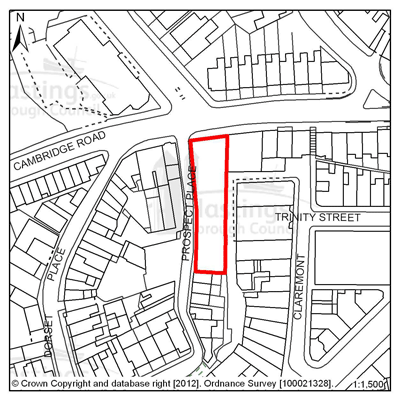
Figure 73: HTC3 - The Observer Building
Site address: The Observer Building
Allocated use: Mixed use (residential and commercial)
Area: 0.07ha
Possible net capacity: 39
6.298 Site HTC3 – The Observer Building – is a vacant multi-storey building that was allocated for mixed use development including residential use in the 2004 Local Plan. The suitability of the site for development does still remain and is an aim of the Council to achieve. The site is therefore allocated for mixed use inclusive of a possible capacity of 39 residential dwellings.
6.299 The Observer Building offers a great opportunity for development; it is a large and imposing building that commands a prominent position on a route into Hastings Town Centre. It is also within the Town Centre Conservation Area and immediately adjacent to two listed buildings. Any new development proposals for this site will be assessed in accordance with policies HN1, HN2, HN3, HN 4 and HN5 of this plan. The mix of uses could include tourist accommodation, retail, educational or leisure facilities as well as residential units. Currently there is no on-site parking and the only access is for pedestrians, so potential schemes will need to include solutions to these issues. Also, given the previous uses of this site, it is likely that surveys will be required of the ground conditions for any potential contamination.
6.300 This site is within an Archaeological Notification Area so any proposals put to the Council will be referred to East Sussex County Council and, in consultation with the County Archaeologist, further investigation works and/or conservation may be required.
6.301 Potential applicants will need to pay particular attention to Policies DM1, DM3, DM4 HN1 and, where appropriate, HN2 and HN3 of this Plan, and Affordable Housing will be required to be provided in accordance with Policy H3 of the Planning Strategy.
 Site reference: HTC4 - 40 & 41 Wellington Square
Site reference: HTC4 - 40 & 41 Wellington Square
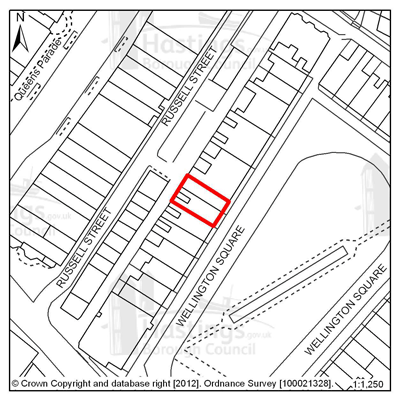
Figure 74: HTC4 - 40 & 41 Wellington Square
Site address: 40 & 41 Wellington Square
Allocated use: Residential
Area: 0.02ha
Possible net capacity: 12
6.302 Site HTC4 – 40 & 41 Wellington Square – where the suitability of developing it for housing has been established through an approved planning application. It is allocated for residential development.
6.303 The details of the scheme, number HS/FA/10/00679, can be found at: www.ukplanning.com
6.304 In the event of a permission lapsing, the decision made on application HS/FA/10/00679 will inform any discussions about future proposals on site HTC4.
6.305 It should be noted that 40 and 41 Wellington Square are listed buildings and this site is within the Old Town Conservation Area. Any new development proposals will be assessed in accordance with policy HN1 and where appropriate HN2, HN3, HN4 and HN5.
 Site reference: HTC5 - 36 & 37 Wellington Square
Site reference: HTC5 - 36 & 37 Wellington Square
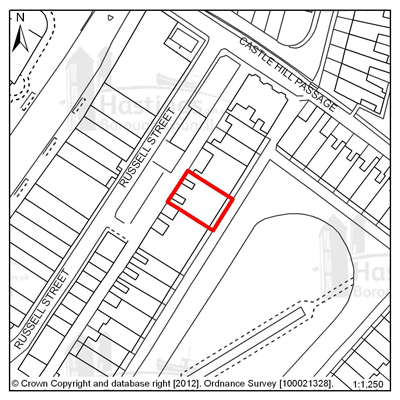
Figure 75: HTC5 - 36 & 37 Wellington Square
Site address: 36 & 37 Wellington Square
Allocated use: Residential
Area: 0.02ha
Possible net capacity: 12
6.306 Site HTC5 – 36 & 37 Wellington Square – where the suitability of developing it for housing has been established through an earlier resolution by the Planning Committee to approve a planning application. It is allocated for residential development.
6.307 The details of the scheme, number HS/FA/11/00177, can be found at: www.ukplanning.com
6.308 In the event of a permission lapsing, the decision made on application HS/FA/11/00177 will inform any discussions about future proposals on site HTC5.
6.309 It should be noted that 36 and 37 Wellington Square are listed buildings and this site is within the Old Town Conservation Area. Any new development proposals will be assessed in accordance with policy HN1 and where appropriate HN2, HN3, HN4 and HN5.
(1)
 Site reference: HTC6 - Priory Quarter, Havelock Road
Site reference: HTC6 - Priory Quarter, Havelock Road
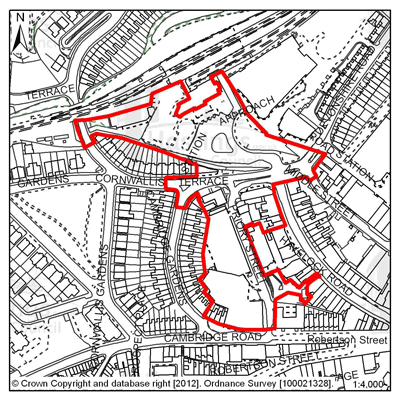
Figure 76: HTC6 - Priory Quarter, Havelock Road
Site address: Priory Quarter, Havelock Road
Allocated uses: Employment - class B1 (and mixed use: Retail – classes A1/A3;
Hotel - class C1; Education – class D1; Leisure - class D2; Car parking – sui generis)
Area: 2.60ha
Potential floorspace (gross): 21,700m2 (of use class B1)
6.310 Site HT6 forms the remainder of what is known as Priory Quarter. An informal master planning framework for the whole area was prepared in 2006/7 which subsequently formed the basis for an outline planning application (HS/OA/06/00896). The outline application, which the Planning Committee resolved to approve subject to a legal agreement, was for a large scale mixed development of offices, education, retail and leisure. A significant part of the proposal was subsequently implemented through separate planning consents and now forms the core of the town centre’s business and education quarter. All this was done as part of the major regeneration initiative led by the Hastings and Bexhill Task Force.
6.311 The proposed allocation is primarily for business development but also allows for other complementary uses – retail, education, car parking, hotel and leisure proposals should they come forward. It covers the remaining part of Priory Quarter available for redevelopment and is expected to be implemented during the period of the Plan.
(1) 6.312 The area has been divided into four phases as shown on the design brief, which can be found in Appendix A:
-
Queensbury House and adjoining sites – Planning permission (ref. no. HS/FA/11/00284) has been granted for redevelopment for a 7,800m2 office scheme in two phases.
-
Station area – Office and/or hotel development; and public car parking to replace the existing Priory Street car park and enable its redevelopment;
-
Priory Street Car Park – Office development plus, possibly, other uses.
-
ESK Warehouse – Office development and/or retail/education
6.313 The split of uses in the four phases is indicative, but business development will remain the prime form of development sought within the site as a whole.
Dependent on the timing and character of redevelopments, additional objectives for the area to be sought during the Plan period will be:
-
re-arrangement of the station forecourt area to improve pedestrian circulation and connectivity.
-
Removal of through traffic from Priory Street and measures to enable it to become a pleasant and safe pedestrian route through the core of Priory Quarter.
6.314 Potential applicants should pay particular attention to policies DM1, DM2, DM4 and SA1 of this Plan. Policies HN1-5 relating to heritage assets will also be relevant, because the site is within the Town Centre Conservation Area. Within the Planning Strategy, transport policies T2, T3 and T4, and economy policy E3, are particularly applicable. Of particular importance for these sites will be measures to reduce surface water flood risk, in accordance with Policy SC7, and Sustainable Drainage Systems (SUDs) are likely to be required. The scale of these sites provides the potential for combined heat and power (CHP) systems, so with reference to policy SC5 of the Planning Strategy, the Council expects the proponents of any scheme to investigate the feasibility of CHP.
6.315 This area is within an Archaeological Notification Area so any proposals put to the Council will be referred to East Sussex County Council and, in consultation with the County Archaeologist, further investigation works and/or conservation may be required.
6.316 Planning permission and Conservation Area consent (ref. nos. HS/FA/11/00284 & HS/CA/11/00285) were granted in 2011 for redevelopment for a 7,800m2 office scheme within the “phase 1” area.
Focus Area 9: Old Town
6.317 Hastings Old Town is the oldest part of the borough, extending between the East and West Hill from the iconic net shops on the beach, up to All Saints Church at the head of The Bourne. Some of the housing and other buildings here date back to the thirteenth century, woven through a maze of narrow streets and twittens that delight both visitors and residents.
6.318 The Old Town has had a mixed history of twentieth century planning. For example, the demolition of housing along The Bourne to create a route for the A259 effectively divided the area in two and was a low point, but there are large areas of sympathetic 1970s redevelopment. The Old Town remains a desirable place to live and house prices here are the highest in Hastings. It is also the densest housing in the town, with few open spaces, although it is very close to the Country Park and West Hill. All of the Old Town is in a Conservation Area, and many of the buildings are Grade II listed.
6.319 2001 Census data shows that the population in the Old Town is the oldest in the borough, with around a third above retirement age. By contrast, only a tenth of the population is under 16, the lowest in the borough. New community facilities at the Stade Hall help to provide a centre for local community activities, and the area is reasonably well served by other community services with the Stables Theatre, a doctor’s surgery, pharmacy, and local food shops.
6.320 There is various employment in this Focus Area; the Hastings fishery at the Stade, with its direct employment of fishermen, as well as many indirect jobs, in related onshore trades, and the tourism that the fishing industry brings with it. There is much employment in retail and catering too, with a thriving network of busy, independent shops and cafes and pubs along George Street, High Street and Rock-a-Nore. There is also a wealth of small studios and workshops, used largely by working artists and other craft-related trades. There is also some more seasonal employment concentrated on ‘traditional’ tourism, with souvenir shops, amusements and all that is on offer on the seafront.
6.321 New development has taken place in the Old Town in recent years, most notably the Jerwood Gallery, Stade Open Space, café and Stade Hall, with the style and design of this being modern and creative but sympathetic to its setting. There is a new hotel in Rock-a-Nore being built, replacing the old ice house that had been derelict for many years. This helps to give visitors to Hastings a wide range of things to see and do during their time here, from traditional seaside amusements, to eating and drinking, to art appreciation and everything in between.
Our Vision for the Old Town
6.322 Since the charm of the Old Town, and its value as a place to live and work, is dependent on its centuries-old character, any new development would have to be sympathetic to this. Almost all of the buildings in the area should be maintained and preserved in their current form, retaining its rich architectural heritage. But this does not mean that there should not be any new development. So we will allow new development in the Old Town, where this complements the existing townscape and does not damage existing historic buildings, both in terms of their physical structure and their visual setting. Any new development here would have to be carried out to the highest architectural quality. But that doesn’t mean it has to be a mock-historical pastiche; the Old Town must continue to grow and react to changing times.
6.323 This approach obviously raises potential conflicts, in particular between businesses wanting to develop opportunities, and the need to conserve architectural heritage. So while we will continue to pay close attention to the materials and construction techniques used in the conversion of existing buildings, we will work with those looking to develop schemes and help them to achieve their aims and aspirations whilst the character and important buildings of the Old Town are preserved for future generations.
6.324 Policy FA5 of the Planning Strategy sets out a range of 50-70 new homes to be built in the Old Town during the next fifteen years, but businesses and new jobs will be just as important. With the average age of the local population growing, and being significantly higher than the rest of the borough, it is important to make sure that young people can remain in the area. That will be difficult if there are no jobs apart from seasonal, tourism-related jobs, and no affordable housing. So we need to promote the creation of both affordable housing, and sustainable employment, particularly with small employers in the creative sector.
Focus Area 10: West Hill
6.325 The West Hill Focus Area is made up of mostly terraced Victorian housing, stretching from the West Hill open space, with its spectacular views across the town and sea, to Mount Pleasant in the west and Torfield allotments in the east, while extending to the north as far to the edge of Halton Estate.
6.326 At the southern end stands the borough’s only Grade I listed building: Hastings Castle. The housing near the Castle is elegant, seaside villas, although some could benefit from some work doing to them. Some of the big, cliff top hotels and boarding houses have also been converted into flats or Houses in Multiple Occupation.
6.327 Moving inland, the houses are larger and more densely packed. Streets here are narrow and lined with parked cars, with few open spaces between, giving the feel of a crowded, highly populated area. Families with children predominate: the area has the lowest proportion of retired people in the borough, but the second highest proportion of children under 16, according to 2001 Census data.
6.328 Some gentrification has taken place in the terraced cottages closest to the cliffs, with many of these having been refurbished and turned into holiday lets or weekend retreats. Most of the housing here is private, beyond a few small infill blocks of ex-council flats.
6.329 2001 Census data supports that this is a busy, densely populated part of town, with over 5,500 people living here, in one of the smallest Focus Areas. The density of population does mean that corner shops, small businesses and local pubs have survived relatively well. There are even some ‘traditional’ workshops and light engineering businesses, mixed in amongst the Victorian terraces. One fifth of the working age population, however, is in receipt of Job Seeker’s Allowance (Department of Work and Pensions – Nomis statistics). While the area is well served by open spaces and children’s play areas, these are all at the southern and eastern edges of the area.
Our Vision for West Hill
6.330 Hastings Castle, owned by Hastings Council, needs considerable investment to bring it up to standard as a tourist destination, making the most of its status as one of the world’s most famous buildings. The vista of open space and elegant housing that surrounds the castle should be preserved. We would, however, encourage the continued development of holiday accommodation in this ‘cliff top zone’, helping the renovation and regeneration of housing back along the streets that lead away from the sea. With local shops serving a community of holidaymakers and residents enjoying sea views and sunshine amongst pretty, colourful streets and seaside gardens, this part of the Borough will continue to be a prime destination.
6.331 However, this whole Focus Area contains few opportunities for new development, and the densely packed terraces would make this difficult. Policy FA2 suggests a range of 60-80 new homes to be provided here over the next fifteen years, and the redevelopment and reuse of existing buildings will be an important part of this. Potential development schemes would have to pay particular attention to local population density, the setting of the Castle, and be sympathetic to the character of the Victorian terraces.
6.332 The small local shops and businesses in this area are one of its assets, so we would want to preserve and improve these. We would look favourably, too, on ideas for new small businesses, especially from the creative sector. Artists’ studios and workshops in particular would fit in with the feel and atmosphere of the southern part of the area.
(1) Focus Area 11: Hillcrest & Ore Valley
6.333 This t-shaped Focus Area, which includes housing predominantly in mid-twentieth century estates, sweeps up from the West Hill to the Ridge and North’s Seat, and borders some of the best natural green spaces in town. The quality of the buildings often appears to be in contrast with the spectacular views towards the sea and also northwards to the High Weald AONB. Ore Valley & Hillcrest also includes the Ivyhouse Lane industrial estate, one of the borough’s principle employment areas. This is on the northern edge of the area and is somewhat disconnected from the many areas of housing that predominate here.
6.334 Hillcrest & Ore Valley is dominated by social housing, in estates built between the 1950s and 70s: Halton, Farley Bank, Broomgrove, Red Lake and Downs Farm. While some of this housing is semi-detached housing with gardens (as in Red Lake), much of it is flats and maisonettes. Attempts have been made to introduce a more diverse mix of housing, with some blocks of flats being demolished. But land values are low and there has been little interest shown by developers, so the sites remain as development potential yet to be realised. There are other redevelopment opportunities here too, such as the semi-derelict Malvern Pub, which the Council is intending to buy through a Compulsory Purchase Order.
6.335 This area also includes the Ore Valley regeneration site, formerly a ‘Millennium Communities’ project, comprising an old railway goods yard and power station. Here, some redevelopment has been completed, with housing built around a new road to the Ore railway station where new offices and shops will be provided. Although the redevelopment of this site has begun, it still offers much potential for further growth.
6.336 The statistics for this Focus Area make for hard reading: over 60% of children live in households below the official UK poverty level (ONS), and there is the highest proportion of children for a Focus Area in the borough. Roughly one fifth of the working age population is on Job Seeker’s Allowance (Department of Work and Pensions – Nomis statistics). Educational and training opportunities are improving significantly though, with the new Sussex Coast College opened in the Ore Valley regeneration area, and the new Hastings Academy at the Hillcrest School site. Other services include community centres and a ‘Sure Start’ children’s centre, but opportunities to increase what is available remain, especially in terms of local retail.
Our Vision for Hillcrest & Ore Valley
6.337 There are already significant redevelopment opportunities on vacant sites at Broomgrove and the Ore Valley. Over the next 15 years, Policy FA5 of the Planning Strategy indicates a range of 440-540 homes is to be planned for. We need a better mix of housing tenures, but any large-scale redevelopment would have to take account of the local economic circumstances, meaning that the current levels of social housing would need to be retained overall, albeit with a better, more integrated mix. While new housing on currently vacant sites could be offered for sale, this is an ideal area for low-cost ‘starter’ homes, giving local social housing tenants a route into property ownership.
6.338 One of the biggest challenges in this Focus Area is the lack of employment opportunities, and the alienation of its young people. To tackle this, we think it is important to bring employment opportunities back into the community, so young people can get jobs locally, go to work, and get paid. So, as well as protecting and improving existing employment land and industrial areas, particularly the Ivyhouse Lane employment area, we want to encourage the development of small businesses within the community – including live/work units, micro-engineering workshops, high-tech internet-based employers, along with more ‘traditional’ local businesses, such as car repairers and builders. Some of these could be retail units, providing not only employment, but also much-needed local services.
6.339 We must also protect green spaces in the area, which provide an important recreational opportunity especially for children. So where development does occur, the opportunities to help protect and enhance open spaces will be encouraged along with, where appropriate, the provision of children’s play equipment.
Allocations for Hillcrest & Ore Valley
| Site reference | Address | Reason for allocation (including potential number of homes) | Area (ha) | Does the site have a brief in Appendix A? |
|---|---|---|---|---|
| HOV1 | Former Stills Factory (part) | Residential (75) | 2.71 |

|
| HOV2 | Ore Valley | Residential (50) | 2.35 |

|
| HOV3 | Mount Pleasant Hospital, Frederick Road | Residential (40) | 1.84 |

|
| HOV4 | The Cheviots/Cotswold Close | Residential (63) | 1.23 |

|
| HOV5 | 87-221 (odds) Farley Bank | Residential (44) | 0.73 |

|
| HOV6 | Ore Business Park, Farley Bank | Residential (37) | 0.70 |

|
| HOV7 | Upper Broomgrove Road | Residential (12) | 0.28 |

|
| HOV8 | 2-20 (evens) Fellows Road | Residential (17) | 0.27 |

|
| HOV9 | 107 The Ridge (Simes & Sons) | Residential (8) | 0.22 |

|
| HOV10 | 5-15 (odds) Fellows Road | Residential (12) | 0.10 |

|
Table 22: Allocations for Hillcrest & Ore Valley
Employment Allocations
| Site reference | Address | Potential gross floorspace (m2) | Area (ha) | Does the site have a brief in Appendix A? |
|---|---|---|---|---|
| HOV11 | Ivyhouse Lane, northern extension | 7,000 | 5.84 |

|
| HOV12 | Land east of Burgess Road, Ivyhouse | 1,400 | 0.51 |

|
Table 23: Employment allocations for HOV
(1)
 Site reference: HOV1 - Former Stills Factory, Ore Valley
Site reference: HOV1 - Former Stills Factory, Ore Valley
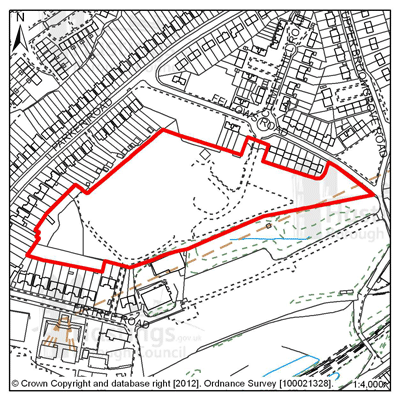
Figure 80: HOV1 - Former Stills Factory Ore Valley
Site address: Former Stills Factory, Ore Valley
Allocated use: Residential
Area: 2.71ha
Possible net capacity: 75
6.340 Site HOV1 – Former Stills Factory, Ore Valley – was allocated for mixed development in the 2004 Local Plan. The site forms part of a wider area of neglected and redundant land known as Ore Valley, the regeneration of which has been a long term objective of the Council. The introduction of new housing to this area is seen as being both beneficial to the immediate locality and to the town as a whole. Ore Valley as a whole was to be redeveloped as part of the national Millennium Communities programme, and the original outline planning permission included housing, together with commercial, retail and higher education facilities. The new Sussex Coast College is complete and in operation, and the first phase of housing is also complete. Nationally, the Millennium Communities programme has now ended. It is proposed to continue to allocate this site for residential development as part of the wider Ore Valley redevelopment area. The site has an indicative capacity of 75 units.
6.341 This site is of a fairly regular shape and is capable of accommodating a mix of housing, which will be determined by market conditions and local housing needs at the time of development. In accordance with Policy H2 of the Planning Strategy; this site may be required to include specific housing for wheelchair users, and Affordable Housing will be required as part of the mix in accordance with policy H3. The site is in an area of mainly two-storey dwellings and bungalows, and the Council anticipates the site being developed with low-rise housing. The Council will expect any development to achieve high standards of sustainable design and construction. Applicants should have particular regard to policies DM1 and DM2 of this Plan and to the policies in the Sustainable Communities chapter of the Planning Strategy. Of particular importance for this site will be measures to reduce surface water flood risk, in accordance with Policy SC7, and Sustainable Drainage Systems (SUDs) are likely to be required.
6.342 Access is available from an existing link to Fellows Road in the northern part of the site, as illustrated on the accompanying Design Brief, in Appendix A. A new access to Fellows Road may also be possible at the eastern end of the site. A pedestrian/cycle link should also be provided to Fir Tree Road to the south. The possibility of linking with site HOV2 to the south should be explored. Although the site has been cleared, applicants will be required to demonstrate that any contamination from previous uses has been dealt with in accordance with policy DM5 of this Plan. The site is also known to accommodate reptiles and an ecological assessment will be required in accordance with policy EN3 of the Planning Strategy.
6.343 There are trees and shrubs on all boundaries of the site and these should be retained in any development. There are opportunities to create open green spaces in the areas in the south western and north eastern part of the site outlined in the design brief. The provision of children’s play facilities may be required in one of these areas. There are also two groups of trees within the site which may be worth retaining.
 Site reference: HOV2 - Ore Valley
Site reference: HOV2 - Ore Valley

Figure 81: HOV2 - Ore Valley
Site address: Ore Valley
Allocated use: Residential
Area: 2.35ha
Possible net capacity: 50
6.344 Site HOV2 – Ore Valley – was allocated for residential development in the 2004 Local Plan. The site forms part of a wider area of neglected and redundant land known as Ore Valley, the regeneration of which has been a long term objective of the Council. The introduction of new housing to this area is seen as being both beneficial to the immediate locality and the town as a whole. Ore Valley as a whole was to be redeveloped as part of the national Millennium Communities programme, and the original outline planning permission included housing, together with commercial, retail and higher education facilities. The new Sussex Coast College is complete and in operation, and the first phase of housing is also complete. Nationally the Millennium Communities programme has now ended. It is proposed to continue to allocate this site for residential development as part of the wider Ore Valley redevelopment area. The site has an indicative capacity of 50 units.
6.345 The developable parts of this site are confined to the southern half and a smaller area to the north. These areas are illustrated on the accompanying design brief (in Appendix A). The remainder of the site is woodland, which should be retained and arrangements made for its management. The provision of children’s play facilities may also be required. The Council would anticipate that this site, which slopes to the south, will be developed with low-rise housing. The site is not however constrained by proximity to existing housing. The housing mix will be determined by market conditions and local housing needs at the time of development. In accordance with Policy H2 of the Planning Strategy, this site may be required to include specific housing for wheelchair users, and Affordable Housing will be required as part of the mix in accordance with Policy H3. The Council will expect any development to achieve high standards of sustainable design and construction. Applicants should have particular regard to policies DM1 and DM2 of this Plan and to the policies in the Sustainable Communities chapter of the Planning Strategy. Of particular importance for this site will be measures to reduce surface water flood risk, in accordance with Policy SC7, and Sustainable Drainage Systems (SUDs) are likely to be required.
6.346 Access is available from an existing access point to Fellows Road at the eastern end of the site. If achievable, a vehicular, pedestrian and cycle link to the south should be provided to link with the phase 1 development and the open space area. Links with the Stills site HOV1 to the north should also be explored. Although the site has been cleared, applicants will be required to demonstrate that any contamination from previous uses has been dealt with in accordance with policy DM5 of this Plan. An ecological assessment will also be required in accordance with policy EN3 of the Planning Strategy. Trees on the boundaries should be retained. The design brief that accompanies this site should be used as a reference to guide potential schemes.
(1)
 Site reference: HOV3 - Former Mount Pleasant Hospital,
Frederick Road
Site reference: HOV3 - Former Mount Pleasant Hospital,
Frederick Road
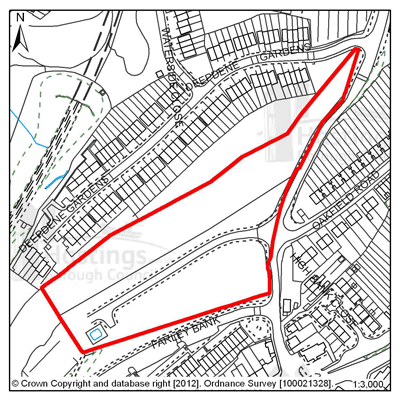
Figure 82: HOV3 – Former Mount Pleasant Hospital, Frederick Road
Site address: Former Mount Pleasant Hospital, Frederick Road
Allocated use: Residential
Area: 1.84ha
Possible net capacity: 40
6.347 Site HOV3 – Former Mount Pleasant Hospital, Frederick Road – was allocated for residential development in the 2004 Local Plan. The site forms part of a wider area of neglected and redundant land known as Ore Valley, the regeneration of which has been a long term objective of the Council. The introduction of new housing in this area is seen as being both beneficial to the immediate locality and to the town as a whole. Ore Valley as a whole was to be redeveloped as part of the national Millennium Communities programme, and the original outline planning permission included housing together with commercial, retail and higher education facilities. The new Sussex Coast College is complete and in operation, and the first phase of housing is also complete. Nationally the Millennium Communities programme has now ended. It is proposed to continue to allocate this site for residential development as part of the wider Ore Valley redevelopment area. The site has an indicative capacity of 40 units.
6.348 In 2004 planning permission was granted for the construction of a spine road to service the site (HS/FA/04/00722). This has been substantially completed and runs north east to south west along the centre of the site. The position of the spine road together with the narrowness of the site suggests that housing development is likely to take the form of frontage development on either side of the road, although there may be alternative approaches that might be acceptable including the potential for more depth of development in the south eastern part of the site. All access should utilise the existing spine road entrance. There is a large drainage storage tank to the west of the turning head, which will need to be protected.
6.349 An Ecology Zone runs the whole length of the north eastern boundary of the site. The extent of this area is shown on the accompanying design brief, in Appendix A. A Management Plan for the area, which has populations of lizards and badgers, was approved in 2005 but will need to be reviewed and updated. The applicants will be required to make suitable arrangements for the on-going management and maintenance of the Ecology Zone.
6.350 Potential applicants will need to pay particular attention to Policies DM1 and DM2 of this Plan and to Policy EN3 of the Planning Strategy. Affordable Housing will be required to be provided in accordance with Policy H3 of the Planning Strategy.
 Site reference: HOV4 - The Cheviots/Cotswold Close
Site reference: HOV4 - The Cheviots/Cotswold Close
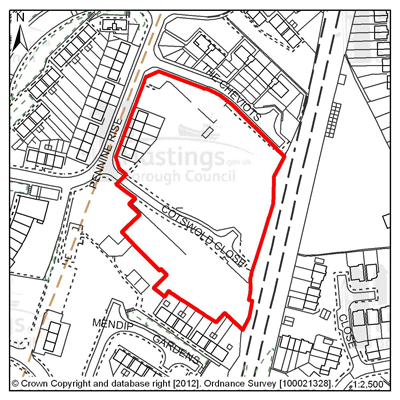
Figure 83: HOV4 - The Cheviots/Cotswold Close
Site address: The Cheviots/Cotswold Close
Allocated use: Residential
Area: 1.23ha
Possible net capacity: 63
6.351 Site HOV4 – The Cheviots/Cotswold Close – where the suitability of developing it for housing has been established through an earlier resolution by the Planning Committee to approve an outline planning application. It is allocated for residential development.
6.352 The details of the scheme, number HS/OA/06/00520, can be found at: www.ukplanning.com
6.353 In the event of a permission lapsing, the decision made on application HS/OA/06/00520 will inform any discussions about future proposals on site HOV4.
(1)
 Site reference: HOV5 - 87-221 (odds) Farley Bank
Site reference: HOV5 - 87-221 (odds) Farley Bank

Figure 84: HOV5 - 87-221 (odds) Farley Bank
Site address: 87-221 (odds) Farley Bank
Allocated use: Residential
Area: 0.73ha
Possible net capacity: 44
6.354 Site HOV5 – 87-221 (odds) Farley Bank – where the suitability of developing it for housing has been established through an earlier resolution by the Planning Committee to approve a planning application. It is allocated for residential development.
6.355 The details of the scheme, number HS/FA/06/00557, can be found at: www.ukplanning.com
6.356 In the event of a permission lapsing, the decision made on application HS/FA/06/00557 will inform any discussions about future proposals on site HOV5.
 Site reference: HOV6 - Ore Business Park, Farley Bank
Site reference: HOV6 - Ore Business Park, Farley Bank
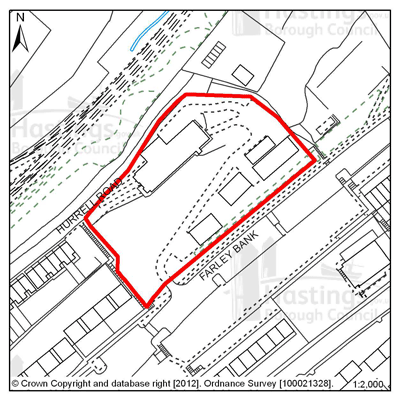
Figure 85: HOV6 - Ore Business Park, Farley Bank
Site address: Ore Business Park, Farley Bank
Allocated use: Residential
Area: 0.70ha
Possible net capacity: 37
6.357 Site HOV6 – 87-221 Ore Business Park, Farley Bank – where the suitability of developing it for housing has been established through an earlier resolution by the Planning Committee to approve a planning application subject to a legal agreement. It is allocated for residential development.
6.358 The details of the scheme, number HS/FA/11/00460, can be found at: www.ukplanning.com
6.359 HS/FA/11/00460 may help inform any discussions about future proposals on site HOV6.
 Site reference: HOV7 - Upper Broomgrove Road
Site reference: HOV7 - Upper Broomgrove Road
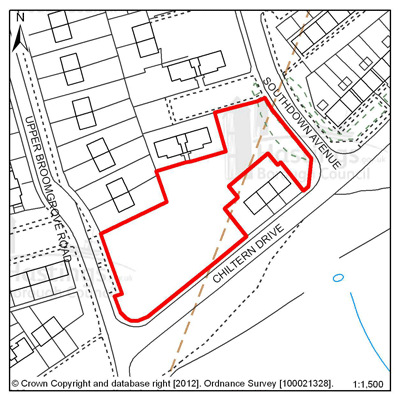
Figure 86: HOV7 - Upper Broomgrove Road
Site address: Upper Broomgrove Road
Allocated use: Residential
Area: 0.28ha
Possible net capacity: 12
6.360 Site HOV7 – Upper Broomgrove Road – where the suitability of developing it for housing has been established through an earlier resolution by the Planning Committee to approve an outline planning application. It is allocated for residential development.
6.361 The details of the scheme, number HS/OA/11/00311, can be found at: www.ukplanning.com
6.362 In the event of a permission lapsing, the decision made on application HS/OA/11/00311 will inform any discussions about future proposals on site HOV7.
 Site reference: HOV8 - 2-20 (evens) Fellows Road
Site reference: HOV8 - 2-20 (evens) Fellows Road
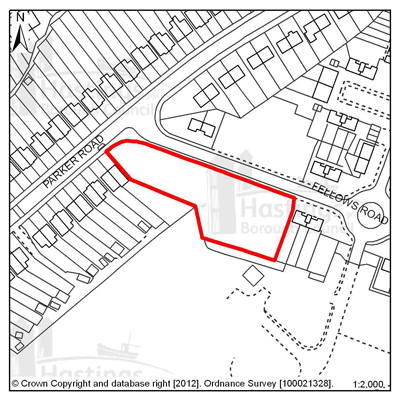
Figure 87: HOV8 - 2-20(evens) Fellows Road
Site address: 2-20 (evens) Fellows Road
Allocated use: Residential
Area: 0.27ha
Possible net capacity: 17
6.363 Site HOV8 – 2-20 (evens) Fellows Road – where the suitability of developing it for housing has been established through an earlier resolution by the Planning Committee to approve an outline planning application subject to a legal agreement. It is allocated for residential development.
6.364 The details of the scheme, number HS/FA/11/00825, can be found at: www.ukplanning.com
6.365 In the event of a permission lapsing, the decision made on application HS/FA/11/00825 will inform any discussions about future proposals on site HOV8.
 Site reference: HOV9 - 107 The Ridge (Simes & Sons)
Site reference: HOV9 - 107 The Ridge (Simes & Sons)
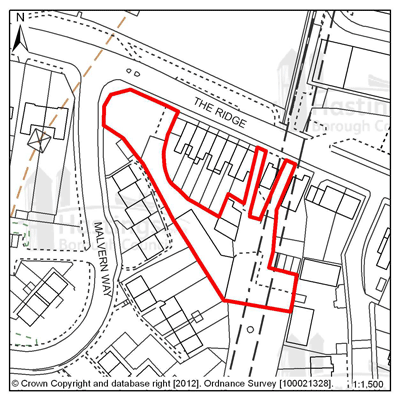
Figure 88: HOV9 - 107 The Ridge (Simes & Sons)
Site address: 107 The Ridge (Simes & Sons)
Allocated use: Residential
Area: 0.22ha
Possible net capacity: 8
6.366 Site HOV9 – 107 The Ridge (Simes & Sons) – where the suitability of developing it for housing has been established through an earlier resolution by the Planning Committee to approve a planning application. It is allocated for residential development.
>6.367 The details of the scheme, number HS/DS/10/00744, can be found at: www.ukplanning.com
6.368 In the event of a permission lapsing, the decision made on application HS/DS/10/00744 will inform any discussions about future proposals on site HOV9.
 Site reference: HOV10 - 5-15 (odds) Fellows Road
Site reference: HOV10 - 5-15 (odds) Fellows Road
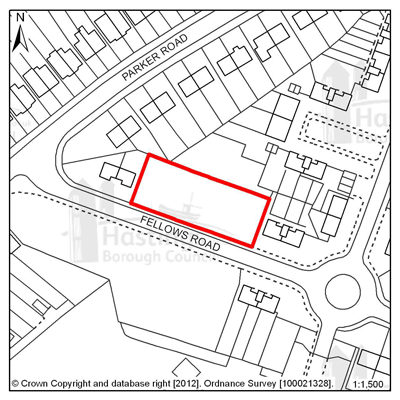
Figure 89: HOV10 - 5-15 (odds) Fellows Road
Site address: 5-15 (odds) Fellows Road
Allocated use: Residential
Area: 0.10ha
Possible net capacity: 12
6.369 Site HOV10 – 5-15 (odds) Fellows Road – where the suitability of developing it for housing has been established through an earlier resolution by the Planning Committee to approve an outline planning application subject to a legal agreement. It is allocated for residential development.
6.370 The details of the scheme, number HS/FA/12/00292, can be found at: www.ukplanning.com
6.371 In the event of a permission lapsing, the decision made on application HS/FA/12/00292 will inform any discussions about future proposals on site HOV10.
 Site
reference: HOV11 - Ivyhouse Lane, northern extension
Site
reference: HOV11 - Ivyhouse Lane, northern extension
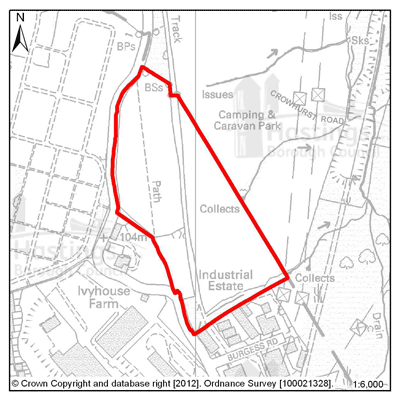
Figure 90: HOV11 - Ivyhouse Lane, northern extension
Site address: Ivyhouse Lane, northern extension
Allocated use: Employment
Area: 5.84ha
Possible net capacity: 7,000m2
6.372 The site is located on the northern edge of the urban area. This undeveloped site would form a natural extension to the existing Ivyhouse employment estate and, subject to detailed examination, has possible capacity for a significant quantity of employment space with scope for a range of unit sizes. It was first allocated for employment in the previous local plan.
6.373 Access within the site should be by means of a spine road which would join Ivyhouse Lane at the southern end of the site. The Highway Authority may require off-site improvements to Ivyhouse Lane in the vicinity of the new access and also possibly an emergency access point onto Ivyhouse Lane further to the north. The Highway Authority will require a transport impact assessment which examines the effect of the proposed development on The Ridge.
6.374 The High Weald Area of Outstanding Natural Beauty extends to the edge of the built up area of Hastings and the site itself falls within it. Although the site has been allocated to meet strategic employment needs, any development should have careful regard to AONB policies. It must take full account of the site’s intrinsic value (including existing trees and hedges), the effect on its setting, and views of it from other parts of the AONB – in particular from the Rock Lane area from where it is visible. The eastern boundary of the identified site is defined by the Borough’s administrative boundary rather than existing physical divisions on the ground and so, to be acceptable, a scheme should be designed such that it creates a new logical boundary. A key landscape feature within the site, consists of an avenue of mature trees and vegetation running, north south, through the site. This green avenue divides the site into two distinct areas. It is envisaged that the majority of development will take place in the area to the west of this avenue, which is visually more contained, but with potential scope for more development in the area to the east, subject to landscape screening. As well as the avenue, there are also a significant number of other trees within the site.
6.375 Also, buffer landscaping to protect the amenity of the adjoining caravan site should be incorporated. Development proposals will be required to be accompanied by both landscape and ecological assessments.
6.376 Hastings Borough Council and Rother District Council have agreed to work together on a joint approach to treatment and management of the fringes of Hastings to secure a clearer definition of the urban boundary and to protect and enhance the rural character of the countryside that immediately abuts it, as well as better access to it. Work on this is expected to produce more detailed guidance (in the form of a Supplementary Planning Document) on joint urban fringes management which, once available, is likely to further inform the development requirements for this site. A start has been made in the design brief for the site that can be found in Appendix A. To allow for flexibility in the outcome of this work, a relatively low assumed capacity has been assigned to this site - 7,000m2 - despite its size.
6.377 Potential applicants should pay particular attention to policies DM1, DM2, and DM4 of this Plan. Policies DM5, DM6 and DM7 may also be of relevance. Within the Planning Strategy, transport policies T2, T3 and T4, and environment policies EN2, EN3 and EN4 are particularly applicable.
 Site
reference: HOV12 - Land East of Burgess Road, Ivyhouse
Site
reference: HOV12 - Land East of Burgess Road, Ivyhouse
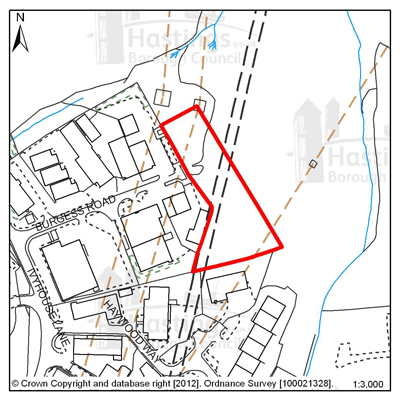
Figure 91: HOV12 - Land East of Burgess Road, Ivyhouse
Site address: Land East of Burgess Road, Ivyhouse
Allocated use: Employment
Area: 0.51ha
Possible net capacity: 1,400m2
6.378 This small site forms part of a larger area - as the full potential development area of up to 1.5ha sits on the boundary between Hastings and Rother. The area within Rother is allocated in Rother District Council’s adopted Local Plan, but this will be subject to review when it prepares its new Development Management Plan.
6.379 The site is mainly wooded and is also within the High Weald Area of Outstanding Natural Beauty, and any development should have careful regard to AONB policies. It must take full account of the site’s intrinsic value, the effect on its setting, and views of it from other parts of the AONB. An ecological and landscape survey of the site will be required, in particular to assess the value of the woodland, some or all of which may constitute ancient woodland. Once a development area has been established, the design should be prepared in a way that incorporates or retains suitable buffer planting.
6.380 Hastings Borough Council and Rother District Council have agreed to work together on a joint approach to treatment and management of the fringes of Hastings to secure a clearer definition of the urban boundary and to protect and enhance the rural character of the countryside that immediately abuts it, as well as better access to it. Work on this is expected to produce more detailed guidance (in the form of a Supplementary Planning Document) on joint urban fringes management which, once available, is likely to further inform the development requirements for this site.
6.381 As well as providing capacity for new employment floorspace, this development is seen as an opportunity to improve the ambiance and quality of the existing adjoining employment sites. The potential benefit of creating a road link between Burgess Road and Haywood Way should be examined. The Burgess Road estate, in particular, would benefit from being upgraded, and a scheme for that combined with this development would be beneficial to the Ivyhouse Estate as a whole.
6.382 The site is traversed by high voltage transmission lines and so the utility provider should be consulted on any proposals.
6.383 Potential applicants should pay particular attention to policies DM1 and DM4 of this Plan. Policies DM5, DM6 and DM7 may also be of relevance. Within the Planning Strategy, transport policies T3 and T4, and environment policies EN2 and EN4 are particularly applicable.
(1) Focus Area 12: Clive Vale & Ore Village
6.384 This Focus Area stretches up the Old London Road from the northern edge of the Old Town to the shopping centre at Ore. In the southern part of Clive Vale, grand Victorian villas enjoy spectacular sea views. To the north at Ore, the housing becomes part of the ‘ribbon development’ that took place in the nineteenth century in many English towns, along the main roads into the town centres.
6.385 Along this eastern edge, the area is bounded by Hastings Country Park, giving a semi-rural feel to houses where the gardens open out into countryside. The western edge is more urban and denser, with few open spaces. There is, however, a heavily wooded valley in the Upper Ore valley that is in multiple ownership, and we are working towards a sustainable future for it.
6.386 The area is well served by shops, doctors and other community facilities, although these are largely in the northern part, at Ore Village. But there are also other smaller local shopping parades at Mount Road and Harold Road, to the south of the area. In Ore Village, however, these services and facilities do result in issues of traffic build-up, especially on the busy A259, where parking is scarce and footpaths are narrow.
6.387 According to 2001 Census data, there are 7,500 inhabitants here, making it one of the more densely populated Focus Areas. It is relatively affluent, however, with 83% of the homes owned by their occupants (Census data). Around 7% of the working population claims Job Seeker’s Allowance (Department of Work and Pensions – Nomis statistics), but only about 2% of the housing is rented from Registered Social Landlords.
6.388 Apart from local shops, there is little employment in this area. The local Victorian trades that would once have been here have all but died out, beyond a few local car repairers and small workshops. In the Clive Vale part, there is a growing community of local artists and craftspeople who work out of home studios, but this is not a significant source of employment for local young people. This is a predominantly residential area, there are, however, good road and public transport links across the Borough and beyond to enable people to travel to work.
Our Vision for Clive Vale and Ore Village
6.389 The character of this area is dominated by Victorian terraces and villas, with distant and often dramatic views of the sea. Any new development schemes in this Focus Area would need to be sympathetic to the Victorian patterns and rhythm of development in the area.
6.390 Policy FA5 of the Planning Strategy outlines a range of 250-310 new homes to be provided here in the next 15 years. Because of the shortage of affordable housing in the area, we would encourage developers who wanted to provide a mix of social and affordable housing. Some of these new homes would also come from bringing empty houses back into use.
6.391 While Clive Vale and Ore Village are likely to remain largely residential, we would consider small-scale employment uses of existing or new property. These should not interfere with the predominantly residential character of the area, but ‘artisan’ trades – for example artist’s studios, specialist craft workshops, specialist niche food makers like bakers or confectioners – could fit with and enhance the area, and provide some local jobs. Tourist accommodation, in the form of small ‘boutique’ hotels, might also be suitable in the grander houses at the seaward end of the area.
6.392 So while we recognise that we cannot set any areas in cultural aspic, we need to recognise and preserve what is best about Clive Vale and Ore Village, both their architecture and their rare open spaces. But we need to encourage economic development too, especially in Ore Village centre, where regeneration investment is still much needed.
Allocations for Clive Vale & Ore Village
| Site reference | Address | Reason for allocation (including potential number of homes) | Area (ha) | Does the site have a brief in Appendix A? |
|---|---|---|---|---|
| CVO1 | Victoria Avenue | Residential (51) | 0.77 |

|
| CVO2 | Land west of Frederick Road | Residential (29) | 0.60 |

|
| CVO3 | Rear of Old London Road | Residential (10) | 0.46 |

|
| CVO4 | Church Street | Residential (6) | 0.35 |

|
| CVO5 | 309-311 Harold Road | Residential (6) | 0.09 |

|
| CVO6 | Hare & Hounds, 391 Old London Road | Residential (6) | 0.04 |

|
Table 24: Allocations for Clive Vale & Ore Village
(10)
 Site reference: CVO1 - Victoria Avenue
Site reference: CVO1 - Victoria Avenue
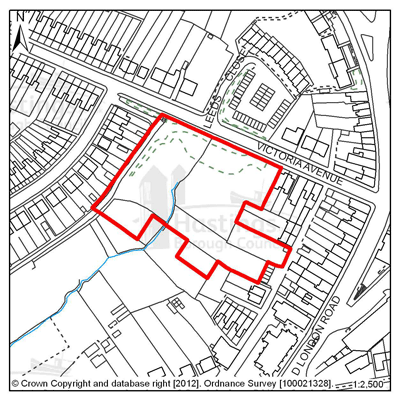
Figure 93: CVO1 - Victoria Avenue
Site address: Victoria Avenue
Allocated use: Residential
Area: 0.77ha
Possible net capacity: 51
6.393 Site CVO1 – Victoria Avenue – where the suitability of developing it for housing has been established through an approved planning application. It is allocated for residential development.
6.394 The details of the scheme, number HS/FA/10/00719, can be found at: www.ukplanning.com
6.395 In the event of a permission lapsing, the decision made on application HS/FA/10/00719 will inform any discussions about future proposals on site CVO1.
(2)
 Site reference: CVO2 - Land west of Frederick Road
Site reference: CVO2 - Land west of Frederick Road

Figure 94: CVO2 - Land west of Frederick Road
Site address: Land west of Frederick Road
Allocated use: Residential
Area: 0.60ha
Possible net capacity: 29
6.396 Site CVO2 – Land west of Frederick Road – where the suitability of developing it for housing has been established through an approved planning application. It is allocated for residential development.
6.397 The details of the scheme, number HS/DS/10/00700, can be found at: www.ukplanning.com
6.398 In the event of a permission lapsing the decision made on application HS/DS/10/00700 will inform any discussions about future proposals on site CVO2.
(11)
 Site reference: CVO3 - Rear of Old London Road
Site reference: CVO3 - Rear of Old London Road
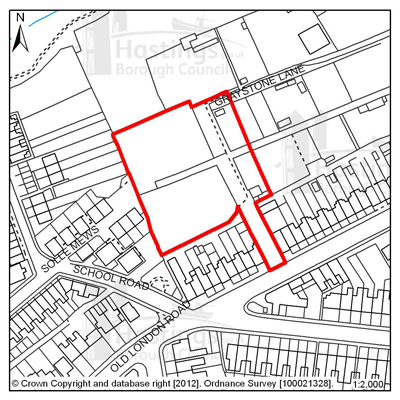
Figure 95: CVO3 - Rear of Old London Road
Site address: Rear of Old London Road
Allocated use: Residential
Area: 0.46ha
Possible net capacity: 10
6.399 Site CVO3 – Rear of Old London Road – was allocated for residential development in the 2004 Local Plan. The suitability of the site for development remains and it is therefore allocated with an indicative capacity of 10 dwellings.
6.400 This is a relatively level site in an area of scrub and woodland surrounded by residential properties. The development of this site could provide the opportunity to open up and aid the maintenance of the adjoining woodlands for the public good. The design brief, in Appendix A, for this site shows where there are some opportunities for pedestrian access and links for the proposed cycle network across the borough of Hastings. Any scheme that is proposed for this site will need to show how adverse impact on surrounding woodland will be avoided in accordance with policy HN8 of this plan, and how landscaping can be incorporated to reduce its visual impact. Parking must also be included on site, because the Old London Road is busy and on-street parking there cannot be extended. The site has an existing but relatively narrow access point that should be taken advantage of but will likely need to be improved, and this is displayed on the design brief for the site.
6.401 Potential applicants will need to pay particular attention to Policies DM1, DM3 and DM4 of this Plan, and Affordable Housing will be required to be provided in accordance with Policy H3 of the Planning Strategy.
(9)
 Site reference: CVO4 - Church Street
Site reference: CVO4 - Church Street

Figure 96: CVO4 - Church Street
Site address: Church Street
Allocated use: Residential
Area: 0.35ha
Possible net capacity: 6
6.402 Site CVO4 – Church Street – is a small area of mainly grassed land that is relatively level. There is an opportunity on this site for a small amount of development that is likely to front onto Church Street.
6.403 Similarly to site CVO3, this site could provide the opportunity to open up and aid the maintenance of the adjoining woodlands for the public good. The design brief, in Appendix A, for this site shows where there are some opportunities for pedestrian access and links for the proposed cycle network across the borough of Hastings. Any scheme that is proposed for this site will need to show how adverse impact on surrounding woodland will be avoided in accordance with policy HN8 of this plan, and how landscaping in connection with the slope that drops away in the south of the identified site can be incorporated to reduce the development’s visual impact.
6.404 The site has an existing access point that should be taken advantage of but will likely need to be improved, and this is displayed on the design brief for the site.
6.405 Potential applicants will need to pay particular attention to Policies DM1, DM3 and DM4 of this Plan, and Affordable Housing will be required to be provided in accordance with Policy H3 of the Planning Strategy.
 Site reference: CVO5 - 309-311 Harold Road
Site reference: CVO5 - 309-311 Harold Road
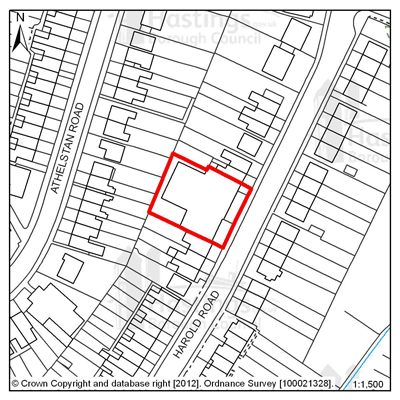
Figure 97: CVO5 - 309-311 Harold Road
Site address: 309-311 Harold Road
Allocated use: Residential
Area: 0.09ha
Possible net capacity: 6
6.406 Site CVO5 – 309-311 Harold Road – where the suitability of developing it for housing has been established through an earlier resolution by the Planning Committee to approve a planning application subject to a legal agreement. It is allocated for residential development.
6.407 The details of the scheme, number HS/FA/11/00641, can be found at: www.ukplanning.com
6.408 In the event of a permission lapsing, the decision made on application HS/FA/11/00641 will inform any discussions about future proposals on site CVO5.
 Site reference: CVO6 – Former Hare & Hounds, 391 Old London
Road
Site reference: CVO6 – Former Hare & Hounds, 391 Old London
Road
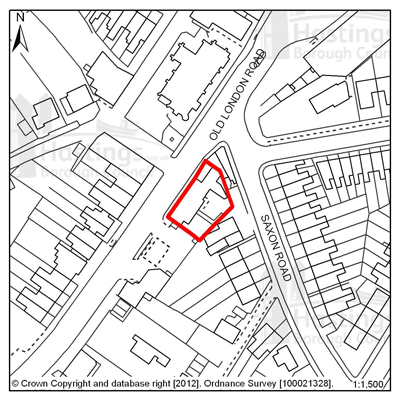
Figure 98: CVO6 - Former Hare & Hounds, 391 Old London Road
Site address: Former Hare & Hounds, 391 Old London Road
Suggested use: Residential
Area: 0.04ha
Possible net capacity: 6
6.409 Site CVO6 – Former Hare & Hounds, 391 Old London Road – has a lapsed planning permission for residential development, and the site’s suitability for residential development has been established.
6.410 The details of the lapsed permission, number HS/OA/06/00729, can be found at: www.ukplanning.com
6.411 The decision made on application HS/OA/06/00729 will inform any discussions about future proposals on site CVO6.
Focus Area 13: Hastings Country Park
6.412 Hastings Country Park is Hastings’ area of true countryside – and it is a very special area of countryside. Gradually acquired by the Borough Council over a century, it is made up of farmland, wooded glens and crumbling cliff tops that, together, make up an area of astonishing natural beauty; a wild, sea-edged landscape where rare plants and uncommon wildlife are present, in an environment little touched by development. This special character is recognised through the area’s legal status too. Declared a nature reserve in 2006, it is a Site of Special Scientific Interest (SSSI), and also a Special Area of Conservation (SAC), a designation which gives it special protection under European law. But it is not a wilderness; people have lived and worked here for thousands of years, and the area has a wealth of archaeology to prove this.
6.413 The Country Park also includes within its boundaries the Shearbarn holiday village, one of the primary tourist accommodation sites in the borough, with camping grounds, caravans and log cabins high on the clifftops looking out over the sea, as well as the smaller Rocklands caravan park.
6.414 The Hastings Country Park Focus Area takes in slightly more than the Country Park nature reserve, including the curiously named ‘Bachelor’s Bump’ area at the north-east corner of the borough. This is where most of the people in this area live, although there are a few small pockets of housing in the Country Park itself, mostly old agricultural housing, coastguard cottages, and the impressive Fairlight Place. Most of this housing is now in private ownership, although almost all of the Country Park is owned and managed by Hastings Borough Council. Even so, while this is the largest of our local Focus Areas by area, it is the smallest by population: only around 1,800 people live here, with over a quarter of them above retirement age (according to 2001 Census data).
6.415 The people who live in this Focus Area generally need to travel to access shops and services, as there are few within it. Road connections to Hastings Town Centre are good, and there are bus routes that pass through, and the presence of these is important to avoid problems of isolation.
6.416 This is an area where the natural environment is of paramount importance. That means maintaining the unspoilt character of the place for those who visit and live there, but more importantly, preserving the rare and sensitive habitats for the park’s astonishingly varied flora and fauna.
Our Vision for Hastings Country Park
6.417 Any development anywhere in the Country Park Focus Area would be tightly managed by existing planning restrictions that apply in SSSIs and the High Weald Area of Outstanding Natural Beauty (AONB), so we are not intending to identify much additional housing in this area to help us meet our overall housing target. Minor development outside of the Country Park itself could be considered, if it were unobtrusive and wholly in keeping with the character of the AONB and would not have an adverse effect on the integrity of the SAC. Within the park, any development would be limited to facilities that enhance the park environment and the ‘visitor experience’ – for example, a new visitor centre and café that fits with the Country Park’s aesthetic, or buildings needed for low level sustainable agriculture. Any development would need to be sensitively built and in keeping with the natural environment. We would envisage that any structures in the park would be environmentally sensitive in their methods of construction, use of renewable energy and water conservation. Environmentally sensitive projects for sustainable energy generation could also be considered. We would want to retain tourist accommodation at Shearbarn and Rocklands too, although any development there would also need to be environmentally sensitive, and limited entirely to tourist accommodation.
6.418 The potential of the Country Park to help local people, especially young people, gain experience in the crafts and skills that are used to maintain an area like this should not be overlooked. So while there would be little additional housing development, there is the potential for employment uses, largely of existing buildings, which fosters this kind of activity.
5 48 Bed residential unit with day therapy suite, outreach and consulting rooms - granted Dec 2006, ref. No. HS/CC/06/00536

